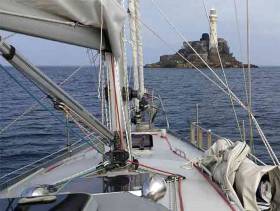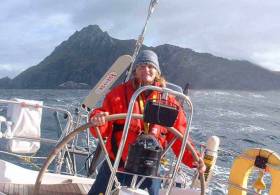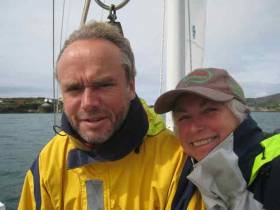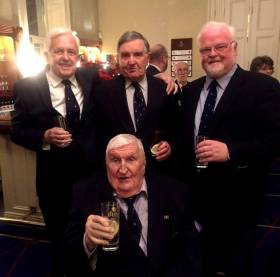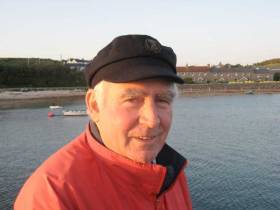Displaying items by tag: Cruising
Cruising sailors Fergus and Katherine Quinlan were presented with an international sailing award by the Ocean Cruising Club in April in recognition of their voyage from Galway Bay to Russia and back in one season. The couple sailed Pylades, a 12m van de Stadt-designed cutter, built in steel by Fergus and Katherine at their home at Kinvara on the west coast of Ireland. The voyage was approximately 3800 miles and was of 109 days duration, beginning this time two years ago.
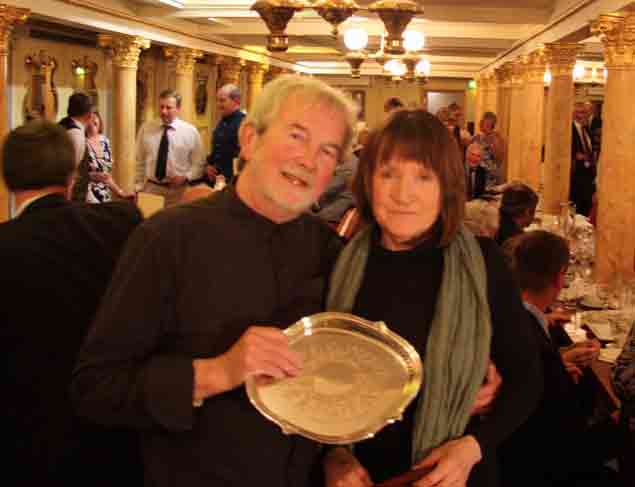 Fergus and Kay Quinlan pictured at the OCC awards in April on board the SS Great Brittan in Bristol with the David Wallis Trophy for their winning log of a voyage from Ireland to Russia and back in 2016
Fergus and Kay Quinlan pictured at the OCC awards in April on board the SS Great Brittan in Bristol with the David Wallis Trophy for their winning log of a voyage from Ireland to Russia and back in 2016
Saturday 14th May 2016: Katherine and I slip Pylades off its mooring at midday and motored west from Kinvara. The sea was quite in the bay, a limpid calmness which extended out beyond the shelter of the Aran Islands. Dolphins accompanied Pylades south, where one pod left off another joined, in the translucent seas they were clearly having fun under a blue sky as they bellied up beneath the bows in a high-speed sex romp. The Blasket Sound and its restless water has many faces but on our first morning underway it was shrouded in a slow fog. Its islands and their outliers were but ghostly images imparting an air of deep melancholy. By contrast the Dursey Sound, a few hours later, was a blaze of bright sunshine with figures who waved us through from both shores.
The Fastnet Rock emerged from a flat ocean in whispers of wind. Reflecting on a previous storm, we motor on our way. The calm allowed the easy sighting of many whales and myriads of dolphins. A waypoint was set for the Seven Stones Light Vessel; it was a cold night on our 3 hour watches. The plotter showing our position and Automatic Identification System [AIS] that of other vessels was, for us, a new experience. We noticed some of the AIS screen images becoming static, an object query revealed that their transmissions were old and thus, we had discovered ‘ghost ships’.
Adding to the nights’ interest, the galley sink refused to drain, grease was the likely culprit. Hot water and chemicals did not sort the problem. Neither did poking with wire. Presses were emptied, the seacock closed and the pipework dismantled, while removing the final connection the bronze flange of the seacock sheared off. Gingerly opening the seacock there was only the tiniest trickle, the skipper plunged a screw driver down the open valve, resulting in the ejection of an impressive lump of grease followed by a 38mm diameter column of solid Atlantic, thankfully the seacock closed to await a new fitting.
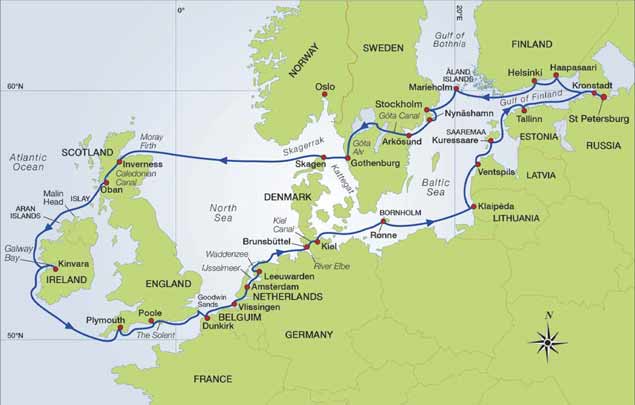
17th May; 06.20 abeam Lizard Point and dodging real ships. Entering Plymouth Harbour, we crossed the ‘bridge’ and anchored in the pool west of Drakes Island. Next morning, Pylades moved to the sixty euro a night, Queen Anne Battery Marina. In the adjacent Marine Bazaar, a tail for the sink outlet seacock was located and full flow restored. 13.00, we exit, bound west. ‘Passage Weather’ forecast wind F2 to 3 fair, the met office coastal F4-5 occasionally 6, with rain. The latter was correct, a rotten night at sea, compounded by ghost ships and AIS images approaching at 33 knots, which subsequently materialised as Motor Torpedo Boats. Later the skipper misjudged a trawler and was forced to jibe. Nevertheless, with wind aplenty great progress was made under a double reefed main and half a headsail.
20th May; Portland Bill Light 6 miles to port appeared through a clearing mist, as did the moon, reefs are released. Diverting to Poole Harbour we recollect the near miss of Hilaire Belloc’s yacht Jersey at the adjacent Anvil Point, a mathematical error by Katherine and Pylades almost followed suit – reduced wine rations. At 10.30 we picked a free mooring. Over the next two days we sheltered, work on boat bits, sip wine and watched the passing parade. Diversion came at night with a wind blowing against the strange tides of Poole, we became tide rode overriding the mooring buoy which dragged itself back and forth under the bow with alarming noises. A restless sleep occasionally altering the chaff points on the lines.
22nd May; with tidal gates calculated we sailed for the Needles, the west entrance to the Solent. The Cardinal buoy approached with an alarming bow wave, we passed within a hair’s breadth. Choppy swirling currents carried Pylades to the home of English ‘yachting’, the Solent filled with boats of all descriptions, we saw more boats in the next hours than in the previous ten years. Following in the path of the Howth Gun Runners we put in to Cowes.
A pleasant place, not overtly expensive. While Katherine did not search for a yachting cap as did Mary Spring Rice in July of 1914, we went in search of the Royal Marine Hotel where the crew of Asgard supped as they waited the arrival of the Kelpie. We were miss-informed that the hotel was now the clubhouse of the Royal London Yacht Club. Following consultation with the club records, we were introduced to Mr John Power of whiskey making fame. He was a repository of knowledge regarding the events surrounding the Asgard. To an expanding circle in the club we explained our quest regarding the relative benefits to the Irish people of the 1916 rising and the 1917 Bolshevik revolution. A club member exclaimed it was the most interesting discussion in the club for many a year. We were invited to give a talk on our return, however we explained that our route home was to be via Scotland. Our idea for a drink in the Royal Marine Hotel did not materialise, it had been demolished. As promised, a copy of the skipper’s book ‘The Republic of Reason & The Poverty Philosophy’ was delivered, not sure what The Royal London YC made of that!
23rd May; We took on fuel and reluctantly exited Cowes at 12.00, weaving our way through the showrooms of vessels and the familiar references gleaned from too many years reading – Practical Boat Owner and Yachting Monthly we left the sheltered waters of the Solent. Out of the blue the roar of a low flying fighter, a Spitfire, displayed its unmistakable profile, it banked at mast height around Pylades linking us back to wars and guns. Its electrifying scream brought back boyhood memories of the passionate desire to fly that ultimate air machine.
24th May; 05.00 passing Dungeness Point nuclear power station, a light wind built on the nose, we motored on and tied at a very quiet Dover Marina. Anne Korff from Kinvara arrived for a nostalgic passage to her origins, Germany. We took the aft fitting off the boom to free a jammed reef, top up the tanks and ensured all was well for the channel crossing. Next morning exiting with perfect timing we catch a favourable tide, likewise, with perfect timing the plotter screen went black, it left dozens of moving AIS images but showed neither the chart nor Pylades position. Improvisation was in order, Katherine repeatedly transferred our position from the GPS to the plotter, at least we knew which ship was going to run us down. The procedure kept us busy and worked, considering the amount of information those on board the Asgard and Kelpie had at their disposal in 1914, we could not complain.
From a position south east of the Goodwin sands Pylades proceeded on the requisite 90 degree crossing of the lanes. A few nervous hours in poor visibility dodging ships approaching from the northeast and then the southwest. At the same time the favourable flood tide swept us sideways down on the Ruytingen SW Buoy. This we assumed was the station of the Ruytingen lightship in 1914, the rendezvous for the yachts Asgard, Kelpie and the German Tug Gladiator out of Hamburg. Through the fog of time and history we imagined the racing hearts of the young men and women aboard those yachts on that 12th July as 1500 guns and heavy ammunition boxes were transferred. How could they foretell what glory, what blood, what disaster, these instruments of death would bring? Reflecting on these rich moments of history we were swept in to the deserted Dunkerque marina at 18.45.
26th May; it appears we cannot escape from the shadows of war! Heavy black smoke poured across the town and beaches of Dunkerque, another Spitfire screamed overhead. Vintage warships filled the bay, hundreds of soldiers in WW2 fatigues swarmed in the surf. Film making was underway, it was the 76th anniversary of the Dunkerque evacuation when 338,000 English, French and Belgian soldiers were snatched by a medley of boats, including yachts, from the approaching fascist army. Reflecting on the divisions of nationalism and competitive greed, forces which still destroy countries and people, the skipper works on the reef block which had jammed yet again.
27th May; through a light fog and past the dissipating warships we pushed along the coast to Ostend where we were greeted by the marina manager Patrick and his dog Shifty who promptly bit the skipper, no blood was drawn but might have been if he had one of the Mausers from the Asgard. An easterly wind hardens and keeps us in Ostend on walkabouts and doing odd jobs for four days.
1st June; 06.00 leaving Ostend harbour entrance a fishing boat trailing side nets lunged at us out of the fog, we spun Pylades on its length and headed out to sea. It was a stressful passage, particularly without the AIS, we were constantly transiting between the cockpit and the radar. The alternator failed, the radar was now draining the batteries, thankfully the fog had dissipated by the time we arrived in the Netherlands and tied at Breskins Marina. After much testing and fiddling we sought professional assistance. An electrical wizard wired in a bigger bulb at the control panel and explained in detail why this would solve the problem, the skipper now short €268 pretended he fully understood. In the meantime, Katherine was working her way through every facet of the computer to restore AIS and the Open CPN charts, to no avail. Northeast winds were forecast to blow firmly for the next week which would greatly impede progress towards the Frisian Islands. The marina manager suggested we travel inland north through the Netherlands. Brilliant, we concurred and bought a copy of the ‘Staande Mastroute’ an astonishing amount of information for €20.
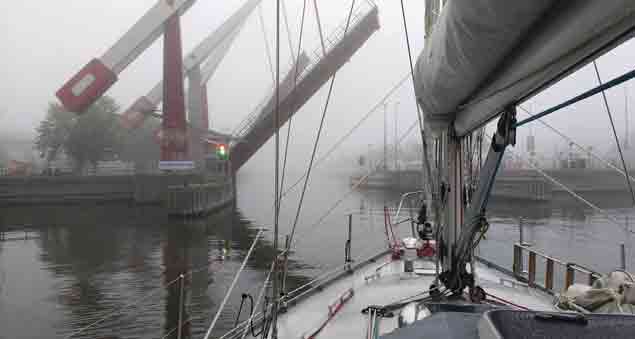 Ghostly Bridges in the Netherlands
Ghostly Bridges in the Netherlands
3rd June, fog and ripping tides herald our arrival through the lock gates at Vlissingen into the calm and amazing canal system of the Netherlands. Motoring through swirling fog; ghostly traffic lights flashed their signals to proceed or pause as spectral bridges swing or lift before us. The infrastructure for the passage of Pylades is a feast of beautiful engineering and is provided as a vast state funded service. That evening we anchored in a pool off the ‘Jachtsluis’. We sipped wine, the cuckoo’s call echoed along the waterways while thunder rumbled in the distance, it was an excerpt from Beethoven’s 6th, the Pastoral Symphony.
5th June, commencing at 05.30 the day was travelled at 5 knots, looking into a thousand back gardens, gliding over motorways, steering our ship level with house roofs, bridges tilting and turning and children jumping into the canal. In the village of Woubrugge we paid €13.00 and rest. Next morning, we shift at 05.00, it was cold under a clear blue sky. After two further days of canal gliding, we arrived at the outskirts of Amsterdam. Heavy rail and road city traffic dictated a night passage. At midnight, bells clang, lights started to flash, we and one other yacht were ready, huge bridges, two rail and two motorways opened, the lights went green and a loud voice from the dark shouts Go! Go! We slammed the throttle to the floor, Pylades achieved a standing start from zero to 7 knots in seconds.
A minute later the bridges closed and trains and trucks resumed their voyages, our hearts were pounding. Over the next few hours we passed 12 bridges and two sluices, during which a man on a high-Nelly bike with coat tails flapping shouts encouragement as he whizzes past. It was he who opened each bridge as we passed.
Suddenly, white lights and a bow wave filled the canal from wall to wall, two full size commercial barges one pushing the other bore down, panic, the yacht in front slowed, if we followed suit Pylades would lose steerage and be sucked into the barge path. We throttled up, passed the yacht at speed and charged, steel barge-walls slid by a fender width to port. Exiting into the Amstel river at 03.00 we were shattered and bewildered by lights and ships. Thankfully the accompanying yacht suggested that we go back into the canal and tie for the night, this we gratefully did and fell into a fitful sleep.
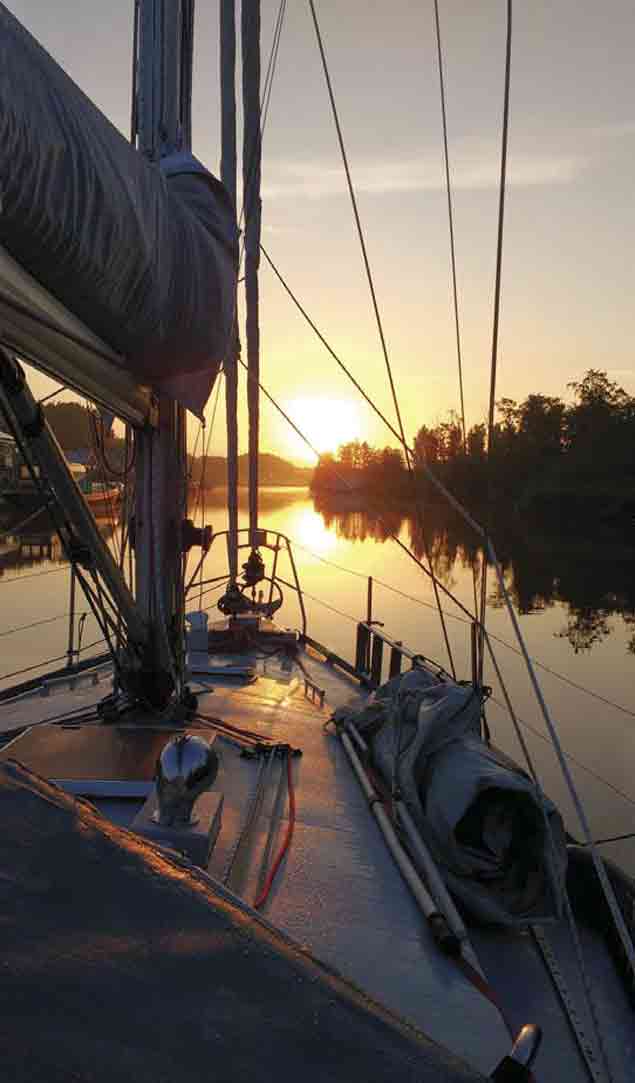 Dawn near the Ijsselmeer
Dawn near the Ijsselmeer
7th June, Anne Korff left to fly home, we crossed to Amsterdam marina for fuel. By 14.00 we were sailing close hauled across the Markermeer. After a choppy approach into Lelystad, we celebrated our progress with a bottle of bubbly. Head winds on the shoal waters of Ijsselmeer forced the use of full mainsail and engine to batter our way to the calm waters of Lemmer in Friesland. Next day we ground twice as we passed a growing concentration of locks and bridges and had further close encounters with commercial barges.
Entering the pretty town of Leeuwarden, a lock-keeper swung a clog on a fishing line to collect a €7.00 toll. For the service we were getting, one could hardly complain, unfortunately in the rush a sterling coin ended up among the Euros. For this crime we were blocked at the next lock by the only keeper in Holland who couldn’t speak English. We grounded the boat into the canal bank to have an animated discussion, passers-by joined in to translate and placate, the people were astonishingly friendly and helpful. Pylades was waved through and we tied to the canal bank further on. Here we watched an air display and observed a jet-fighter stalling, it didn’t recover. Thankfully the pilot had ejected and landed with cuts, bruises and a few broken bones in a glass house, the jet hit another glasshouse and destroyed its tomato crop.
10th June; on the approaches to the Lauwersmeer in centre of a well-marked channel we ran hard aground. No amount of engine would get us off, we opened the full Genoa but the wind was insufficient to help. Just when we needed a big motorboat, there are none about. Two yachts eventually approached, from the north a traditional lee boarder and one from the south. They combined forces with our engine and got us off. Their shouted instructions were to stay close to the red marks away from the centre channel, every day we got a little more confused. In Yachthaven Lauwersmeer, the chilled bottle in our fridge exploded, we went for pints in the bar. Here we met the only Irish flagged boat of our journey, a Drascombe lugger on its way to sail in the wake of Dulcibella, the featured yacht in ‘The Riddle of the Sands’. A book written by the same Erskine Childers, who’s real life adventures in running rifles from the Ruytingen Lightship back to Howth, we were following.
The next day we passed the final lock and into the Waddenzee. Adjusting to a more solitary life Pylades pushed northwest between the Friesian islands of Ameland and Schiermonnikoog. We grew apprehensive, one of the buoyed routes shown on our chart had disappeared, another, the one we were following headed out into the North Sea and did not correspond with what we had. Proceeding further our soundings decreased and higher grew the sea. Many miles out from the shore where we could barely see the islands were sandbanks and breaking seas. Just when despair was about to consume us, the soundings went from 3 to a more tolerable 10 meters. For a crew used to the generous depths of the west coast, the experience was to say the least, stressful.
An easterly wind and tidal calculations decided that we should return to shoal water and land at the German Island of Borkum, again the entrance channel was surrounded by ribbons of banks with erratically breaking seas, it was indeed, a riddle of the sands. We were trying to imagine the difficulties without GPS, to get accurate bearings on the low islands would have been, tricky. An ill designed pilot launch passed very close at speed and buried us in its wash, one of its crew ran to its stern waving an apology. In the still harbour of Borkum we lay alongside a friendly German yacht.
12th June; a bus ride into a fairly dull holiday resort town, a German version of Butlin’s Holiday Camp. Noon next day we headed for deep water. With the wind on the nose we motor tack and battered our way 80 miles overnight to the river Elbe and Brunsbùttel. During the darkest hours, we saw a bank of lights stretching miles across our track, it was an anchor field. Like an ant amongst the elephants we threaded our way through 18 anchored light festooned vessels. 03.00 on this wet grey morning we left the German Bight and were sucked by the tide into the Elbe, sticking to the starboard edge of the channel a chain of grey ships with frothing bows overtake on their way to Hamburg. We found a gap in the procession and gunning the engine, skidded across the river to the gates of the Kiel Canal.
By 09.00 we were in the first lock with a ship and a scattering of small boats which had materialised out of the rain. This 60-mile short cut into the Baltic was built primarily to facilitate German Naval power prior to the First World War, it is so wide and straight that much of the passage could be on auto-pilot. Halfway along the canal we tied to the rain soaked marina at Rendsburg, an interesting medieval town.
15th June; 12.30 transiting the final lock, we entered the Baltic, canal fees, to our delight had been abolished. The marina at Kiel was fairly full, but after much manoeuvring we found a slot for €20 per night. Walking the city, thundering rain forced us into a shopping mall and hunger forced burgers and chips. A €10 taxi with busy wipers got us back to the Pylades wine bar. The morning brought fair weather, hiring a pair of high bikes we whizzed along the myriad of cycle lanes in a city where bicycles and pedestrians seem to have priority. Our new transport system shuffled, oil, laundry, shopping and finally a new chemical toilet for the confined waters of the Baltic and canals. The toilet on Katherine’s bike combined with a tricky back-peddle brake saw her crashing, thankfully without damage to either to rider or goods.
17th June; Kiel Week, the biggest sailing festival in the world with 2000 boats partaking in all sorts of events commences. To make space, we exit for the bleak and shallow marina at Wendtorf. Next morning found us underway to the island of Bornholm, Denmark. A securite call from German warship Rothwild warned of an underwater explosion at 12.45. the position given was about seven miles off, the warning was repeated every fifteen minutes and a final countdown over channel 16 in which the whole bridge of the warship participated. A few seconds after the zero there was a mighty dull double thump followed by an eerie silence. The skipper will regret for life, not calling and ascertaining that all was well on the warship, wishing them well and to enjoy the large fish supper. The wind was westerly and picking, under two reefs and some Genoa, cheered by a red sunset and under a full moon we fly along. Ships lights slid by in all directions. The next morning with more luck than ability the skipper cracked the electronic glitch, the AIS, GPS and the electronic charts were finally brought back together, bliss.
19th June; the following sea grew boisterous and the water shoal as we approached Ronne harbour in Bornholm. Calling the harbour for advice they said “you will probably be OK”. Apprehension peaked when there was no entrance green buoy as shown on the chart. As we rounded into the harbour the layout had changed from the chart, we tie and spend a day shopping, walking and fixing the staysail.
21st June; Mid-summer, was cold and the rain poured, but hope springs eternal, the barometer was 1011 and rising. Behind schedule, we skipped Poland and headed to Lithuania, with one reef in the main and a poled-out Genoa we ran east. An urgent call on the VHF stated that we had entered a prohibited area, a large tug escorted us away, it was only a minor course deviation. Air pollution in the Baltic on a clear day showed a brown mist on all horizons and at night only the glow of the main stars penetrated, of the milky way there was no trace. At dawn on the 23rd we entered the extensive harbour of Klaipeda, found a deserted yacht harbour and slept. A few hours later a gentle knocking and a kind face asked to move to Castle Harbour, “not a bother” we replied. Passing through an intriguing hand operated swing bridge we tied at a picturesque marina. The harbour master said they ‘maybe’ never had an Irish boat, he unfurled an Irish flag, we thanked him, even if it looks Italian.
 Good company in Latvia
Good company in Latvia
24th June; A warm day spent walking the attractive town and sipping coffee in sidewalk cafes, people watching. Observing the almost complete absence of advertising and women wearing high heels, we developed an opinion, imagined or otherwise, that in the former countries of the USSR women walked as though they were about to go on stage, was it all that socialist gym and ballet? The next day calm and under a blue sky we pushed north. To starboard an interminal ribbon of sand that comprised the coasts of Lithuania and Latvia backed by a pine forest, its perfume washed over us. At 21.00 the idle offshore breeze got bored and dumped a squall with 35knots of wind, thunder and lightning on us, the sea built and died quickly.
26th June; 07.00 arrived Ventspils in Latvia and tied bow on with stern buoy. The only boat in the marina we received a warm welcome. We visited the Castle of the Livonian Order, basically they were an armed gang from 1230’s involved in various power grabs while enforcing the dominant superstitions of the era as a cover. Next morning went for a plunge off the nudist beach, the grey morning did not invite a long stay. Exited at 18.00 into a fine night with a light westerly a few ‘cities of light’ liners passed on their way to and from Riga. In the calm morning, we entered the three-mile approach to Kuressaare on the island of Saaremaa, Estonia. Narrow and only 2.7 meters deep with birds standing on shingle beaches at both sides of the boat. We were the second Irish boat in 12 years, in our honour, the tricolour was hoisted on the marina’s yardarm. There were 132 spaces in the marina with six boats.
 Hells Angel
Hells Angel
Hiring a 49cc scooter with helmets, we both squeezed on to the tiny bike and roared off into town. Katherine shouted from aft to keep the speed down, the skipper retorted that we were doing just over 20 mph and were at full power. We got a camping gaz cylinder filled €5.00, go shopping, do the sights and rode into town for beers, our nightmare would be a line of 1000cc ‘angel’ bikes in front of the pub, thankfully there were none, our image and self-esteem are maintained! Next morn after a swim in murky tepid water, Katherine attempted wheelies on the scooter and we hand it back.
30th June; at dawn, we pushed north through the shoal channels between Hiiumaa and Vormsi and out into the Gulf of Finland, only two yachts sighted. Next day we entered the guest harbour of Pirita, built for the Moscow Olympics of 1980, now ‘down at heel’. The bus took about 15 minutes to the medieval city of Tallinn, fascinating with winding narrow streets and myriads of little bars and restaurants. An evening of splendid wine, food and ambiance in ‘Franks Bar’. Next day more exploration soaking up its history and architecture, we examined a spacious church which having been used as a centre for dance during the socialist period was gloomily being restored for worship.
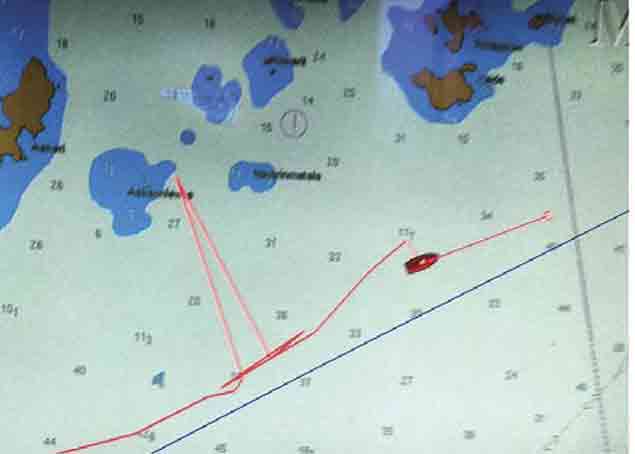 Who is messing with GPS?
Who is messing with GPS?
3rd July 03.00 a red thundery dawn with a light wind astern, the barometer was falling, there were warning of gales as we crossed the Gulf of Finland bound for Haapasaari, Finland. Some ships were transiting the gulf, but no other yachts were sighted. Closing the Russian border, the GPS position of Pylades went wild, jumping a mile back west, then east, then north, it took about 15minutes to settle down. In the meantime, the skipper was transferring ‘old type’ compass fixes on to a chart. With binoculars, we picked out the leading channel buoys. Later asking the Finnish Border Guard, who might be responsible, “impossible to know” is the answer, the Russians, the Americans or NATO. We entered the tiny landlocked harbour and tied at a timber pier, unfortunately on top of a rock, where, in a rising gale we bumped through the night. Next morning at the diesel dock, Sonia the all-round shopkeeper, dock and diesel master, switched on the pump whilst instructing that if the dock pump did not work, “tickle it with your finger, my pump I think she is a woman”. As the rain lashed and the wind howled we fill with diesel and wandered the beautiful island. Costs were €10.00 per night.
An islander knocked on the boat and invited us to the community centre where an exhibition of historical photographs was on display, then to his house to meet his father. We learned about Haapasaari and its history. There are 70 houses on the island, during the winter only about 10 are occupied. Each house has a flagpole, when occupied they hoist a long tail version of the national flag, to inform all that help or company is available. This custom seems to prevail throughout Finland and Sweden. He warned us that the island has ticks some of which carry a risk of infection and advised against walking on the grass barefoot, adding that his brother was infected resulting in brain damage. We think they need a St. Patrick here to go banishing!
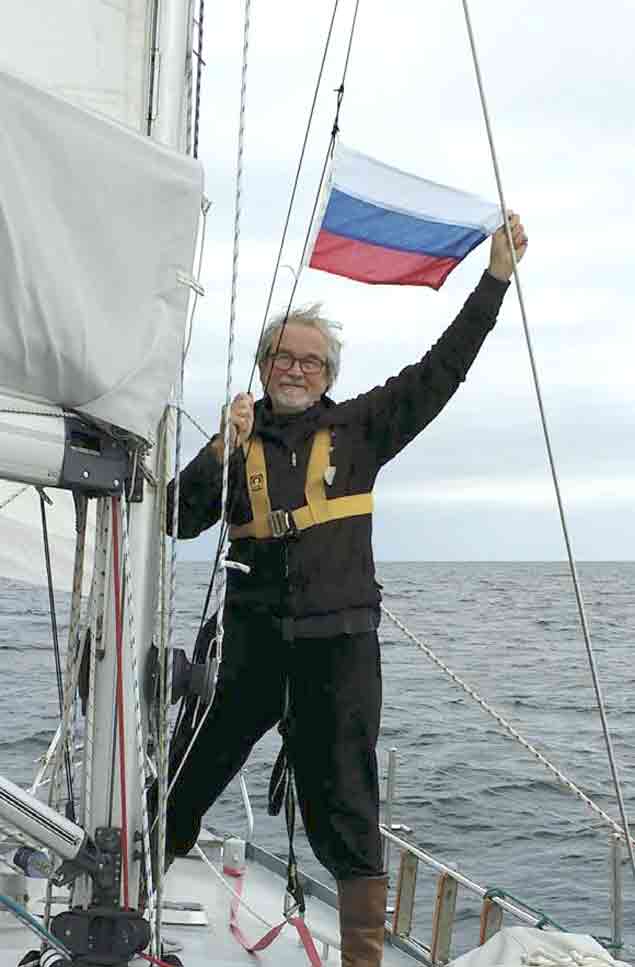 Entering Russian Waters
Entering Russian Waters
6th July; the gales ease, barometer 995 and rising, we checked out with the Finnish border guard and at 13.30 set course for Russia. At 15.35 crossing the border, we contacted the Russian Coast Guard, a deep gravelly voice bade us proceed. Hours later they call, “yacht Pylades, confirm that you are eight cables south of Somers Island”, we respond, correct that is our position; “proceed”. By 03.00 the following morning the westerly wind and sea had increase. While the marked shipping lane is dredged to accommodate cruise liners the approach to the Kronstadt had the feel of shoal water. During the final mile, the waves became very confused bouncing back from the fort walls, we hand steered. Through the entrance the lights were blinding, we approached the dock a woman in a soviet looking uniform booms “tie here”. The skipper leapt ashore and shook hands, she almost smiled and instructed regarding passports and
A thin uniform with a mustache arrived, he searched the ship and pulled out all our wine bottles. We believed that wine would be exorbitant in Sweden and Finland and loaded in Germany for the voyage. He photographed the hoard and left. Customs arrived and explained that we were only allowed four bottles each, much rancour and debate followed, but they had superior firepower so we lost about 45 bottles. The whole procedure had taken six hours, with resolute stoicism we re-hoisted sail and scudded east before the rain and wind.
On our final approach the thudding beat of Shostakovich’s 7th ‘The Leningrad symphony’ fills the cockpit. It had been first performed when the city was under siege by the German and Finnish armies, the most lethal siege in history, over 900-days one and a half million people died from bombardment and starvation. Hitler commanded that it be erased. The musicians who played at that heroic première were starving, three had died during rehearsals. To silence German forces, a Soviet military offensive, was launched just prior to the performance which was broadcast live to the city and German lines by loudspeakers. This première was considered by music critics to be one of the most important artistic performances of the war, its psychological and political effects triumphed over the soulless Nazi war machine. The concert prompted an hour-long ovation, one that still echoes.
High speed hydrofoil ferries darted past in all directions concentrated the mind, we kept our cool and maintained slow, steady, progress along the starboard edge of the channel. We then lost our cool when we saw a bridge under construction across our course to the marina, it was not shown on our chart. We steered for the unfinished gap; (later we were informed that our air draft of 15meters would not have been a problem anywhere under the bridge). The buoyage at the other side was missing so we gingerly sounded our way into the Central Yacht Club Marina. There, to our delight, through the rain, we saw the unmistakable Vladimir Ivankiv, waving. After handshakes and hugs we realised that we had reached the Russian Federation and the end of our journey east.
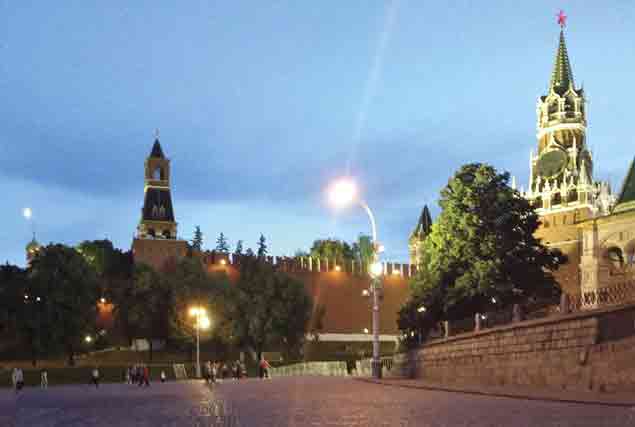 A rising moon in Red Square
A rising moon in Red Square
8th July; In need of exercise, we walked to the centre of Petersburg, the city slowly opened before us with all its waterways and magnificent architecture, even if somewhat gaudy to west European eyes. Soaking ourselves in its ambiance, we had a delightful lunch in town and travelled back to base on the amazing metro. One never had to wait for a train, it was always there or just coming. The grip of the new oligarch culture is apparent. The copious collective ‘propaganda’ posters pushing for gender equality, race equality and international solidarity of the soviet years, have been replaced with ‘advertising’ for personal consumer goods, motor cars and white teeth.
 At the Kremlin
At the Kremlin
After another day exploring the city, we caught a train to Moscow on Sunday morning, traveling at up to 150 miles per hour, the Sapsan Express covered the 400 miles in under four hours. At €75 per night for two including breakfast, the hotel was excellent, how large the bed seemed after our boat bunk? The rest of the day was devoted to sightseeing. The scale of the city is vast, its people overtly friendly. The written language is extremely difficult to decipher, such as when we were trying to match a street name to a map, however when we did produced a map, people inevitable approached and would go out of their way to help and explai
And we danced by the light of the moon When Katherine was a young girl, she dreamed that one day she would dance in Red Square. That evening at Kremlin’s wall, we danced by the light of the moon.
13th July; we met with representatives of the Moscow Museum of Architecture as part of our quest to bring an exhibition of VKhuTEMAS to Ireland, but that is another story, click on the following….. Bolshevik Avant-garde
Our return to Pylades was via the romantic overnight sleeper train, all booked by Vladimir, our amazing OCC port officer. We wandered Petersburg again, unfortunately two places on our visiting list, the battleship Aurora had been removed and the Museum on Siege of Leningrad was shut and looking neglected. (The Aurora has been refurbished and is now back on station).
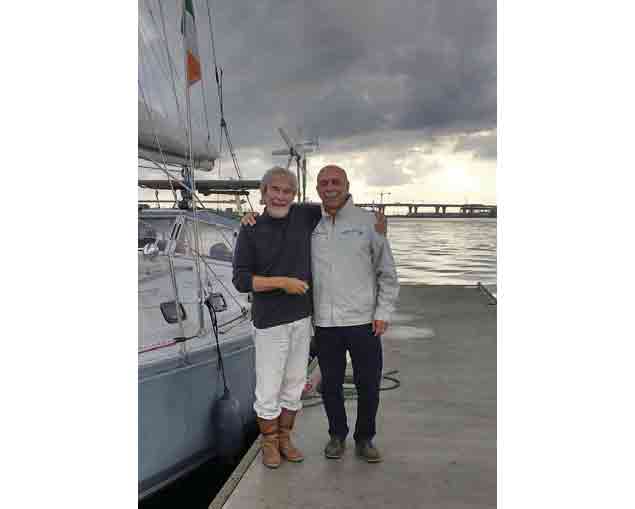 Farewell to Vladimir Ivanikov
Farewell to Vladimir Ivanikov
Time to leave, bidding farewell to Vladimir we presented him with the skipper’s book, took some photos and headed for the Kronstadt. We checked out without incident although the customs officer looked distinctly sheepish. Outside, the westerly wind was throwing up a nasty sea, progress was slow and the engine, being in high gear was complaining bitterly. We had to run off downwind to change the pitch of the Gori propeller, turning up with higher revolutions, we hoisted the mainsail and for six hours battered our way west. At 17.00 the wind had eased and we reset the propeller pitch, eventually the wind died completely and the sea went silky smooth. Crossing from Russian to Finnish waters washed with the light of a spectacular sunrise, Sibelius’s ‘Finlandia’ filled the air.
15th July; 04.00 tied at the Custom dock in Haapasaari and slept for five hours. By 09.45 were cleared and on our way. The wind was east 20 to 30 knots giving exhilarating sailing through the archipelago, due to their twisting nature most of the passages required hand steering and this was to hold true until departing Sweden. Pylades is set up with its plotter at the navigation table, waypoints being transferred to a simple above deck pointer, no problem for long distance, but the more common arrangement of an aft wheel and instruments would be handier in these waters. Our arrival in Lovisa was entertaining for the crowds gathered for the traditional boat festival. In the fresh breeze the skippers boat handling went pear-shaped, but an able seaman boarded to bring us to a different berth, we ran aground. Eventually we got off, got in, tied and settled. The town was pleasant, immaculately clean, built on a strict grid pattern. We visited the cathedral; the caretaker described its history explaining that the town has 8000 inhabitants and this church had services every day and two on Sunday. Now they have just one on Sunday with about 25 to 30 people in attendance. The building is extensively used for music recitals.
17th July; strong wind warnings persist in the gulf but we got used to its complexities and its swell free sheltered waters. It was cold and grey as we sailed west, by 16.00 we were in Helsinki, the marina was €25.00 a night, excellent showers and in the centre of a magnificent city, we loved it. For two days we luxuriated in the reflected ambiance of one of the world’s most egalitarian and advanced societies. We sat at a sidewalk bar and shared an excellent bottle of cava for €15.00, counted our blessings and deliberated on how one might develop such a society back home.
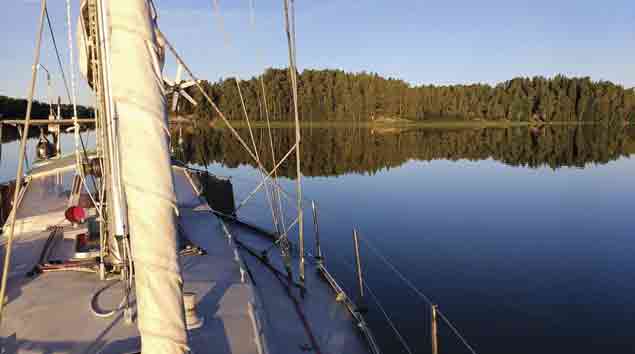 Anchoring in Finland
Anchoring in Finland
19th July; a calm summers day motoring until 17.00 we anchored off the fairway near Barósund. an idyllic location. The following morning at 05.30 we were under way, the water a mirror giving a perfect double take on this land of a thousand islands. In the city of Hanko, we caught up on our laundry and fixed the persistent leak in the pumped water system by replacing the accumulator tank with a new length of pipe. In this sociable harbour, Pylades being steel and grey with wind vane self-steering and solar panels, sparked discussions on boats and sailing grounds. More than a few expressed reservations about sailing in the tides and swell off the Atlantic seaboard, perhaps they had a point!
22nd July; 05.30 tricky exit as we were boxed in with stern lines, but get away without disturbing the natives. On these early mornings we seldom met other boats in the channels, by 10.00 Finnish and Swedish flotillas were passing in all directions until about 17.00 when all quietens. Later in the day we entered the archipelago of Äland, anchoring near Kökar. We have never used the engine as much but with calms, contrary winds and twisting channels one had little choice. On the afternoon of the 23rd July we tied at Marieholm, capital of the Äland Islands, a port busy with cruise liners, ferries and the last of their splendid old sail trading ships. We walked the woods to town and slept well. A troop of Irish scouts cruising on a tall ship paid us a visit, it was refreshing to see such a fine bunch of boys and girls.
25th July; the wind vane came out of hibernation, even though the passage to Sweden had only 25 miles of open water. There were ferries and even a few boats on passage, we anchored off Söederfladen and changed courtesy flag and timepieces. Next morn, we were away at 04.30 inhaling the wonderful pine fresh air of Sweden, by 13.00 everywhere one looked there were pleasure boats and ferries of all sizes. Entering the marina at Nynäshamns in a stiff breeze, our effort to get an instant bowline around the stern buoy went wrong and we tied it around the runner attachment, the wind put tons of pressure on the knot and we had to cut our way out. Hoping no one was watching, we went for an easier berth.
The marina had an excellent shower area, a shoe rack at the entrance, a spacious undressing room, an even larger open shower room, then a sauna where in searing heat one looked at boats through large triple glazed windows. A delightful ritual, even down to the dousing of coals to envelop the naked in steam. This homage to the body has a humanist feeling, perhaps a replacement to a declining theist beliefs. But maybe the explanation is more mundane, with few decent pubs, where else to spend long Nordic nights.
An expensive day, engine oil and gearbox ATF were changed and the Gota Canal booked on line for €718.00. We went to the ‘Systembolaget’ these are a chain of state owned shops for selling any alcohol over 4% proof. The prices were not as bad as we were led to believe- not as cheap as Germany- but definitely not worth the effort of stocking there and losing it at the Kronstadt. The shops were elegant, well stocked and the staff most helpful. A staff member explained that they are a state monopoly, they search the world for excellent wines, “our minimum purchase is 50,000 bottles, so we get quality wine at good prices for our people”.
29 July; Our navigation had been pretty good to-date, we were good at dodging trees, but that day we were heading into the wrong woods, a quick turn from the inlet leading to Norrköping to the correct one to Mem. We tied at Arkósund and uncovered the main Swedish fetish, it’s not sex or saunas, it is ice cream. Everywhere, queues for ice-cream. The ground shook as a motorcycle gang rode into town, studded jackets, tattoos, rings everywhere, the menacing formation pulled up in line and kick dirt as they sauntered into – an ice-cream parlour! Lutheran-bikers we concluded, the type who roar into town, fix things, pick up litter and roar off.
In the upper reaches of the Slätbaken inlet the scenery became rural, cattle in the fields, deciduous trees, we eased our way out of the Baltic. At 12.00 we checked in to the Gota Canal, all efficient and friendly, before we realised it we had passed through the first three locks to Soderköping. Next day ten locks and the crossing of Lake Asplängen, it was solid work for two, particularly Katherine who jumped off before each lock, carried the bow line forward and picked the stern line with a boat hook. For ascending locks, the stern line was secured tight and a line from the bow fairlead runs to a winch where the skipper grinds the slack as the boat rises. Each lock had its own complication. The staff were very friendly, they were not supposed to help with lines, but some did.
1st August; Pylades and a Swan 46 touched in a lock leaving a mark about the size of a small postage stamp on the hull of the Swan. The German owner went ballistic, started shouting about how the boat must be polished, during the altercation the skipper of Pylades suggested that perhaps the skipper of the Swan should take up golf, that didn’t help. Everyone else in the lock went quietly about their business. By 11.30 we were crossing choppy Lake Roxen, as we progressed through the day most other boats tied along the way and we found ourselves alone in the last bank of locks, we relaxed in Ljungsbro.
3rd August; Vattern was choppy, wind still on the nose but it was only 15 miles across. After a few more locks we rose to the highest point Pylades reached in Sweden, 93 meters over sea-level on stunningly beautiful Lake Viken. It fairly took our breath away on that fine morning, a place of magic, conducive to the birth of fairies and trolls. At the end of the lake we dashed through some bridges and tied at Töreboda, from then on it was downhill all the way and much easier. We finally left the Gota Canal at Sjötorp onto the vast Lake Vänern, cold and rough and again the wind blew from our destination. Thirteen hours later we called the rail bridge at Vänersborg, the polite reply said “come”, lights changed and a huge rail bridge reaches for the sky. It was a lovely town to roam.
Our next stop Trollhättan was also very beautiful, we stayed a few nights before descending its flights of locks to the Göta älv. Heading downstream, the river current gave us an additional 1.5 knots, however the wind gusting 35 knots on the nose was churning the water. Seeing a slot in the Gothenburg marina we executed a hairy manoeuvre, and got away with it. At €51.00 per night it’s was not the place to hang about, but we were not for moving. Through the night our rigging screamed and so also did the adjacent marina sign as it shredded. Next morning in a lull we moved further back and shelter behind the opera house. It’s a great walkabout city and we celebrated our arrival with a meal out at an excellent ‘Tapas’ bar.
10th August; discovering to our amazement that there was no diesel outlet in the city, we head off searching in driving cold rain. We were directed to a marina five miles downstream, where we wandered through thousands of vacant boats, finally locating the card pay pump, it did not work. The skipper’s expletives are unprintable. A helpful fisherman arrived and offered to fill for free, but his tank was empty. We found a berth and reckoned that if we had tried to pay we would be still there. Ten miles north the next day in Bjorko we bought fuel from a real live woman who persuaded us to stay, we did, it’s a gorgeous island, the sun came out. We walked in the woods and love it. Later three fully costumed Vikings with beer cans came aboard and sang songs of dead communists!
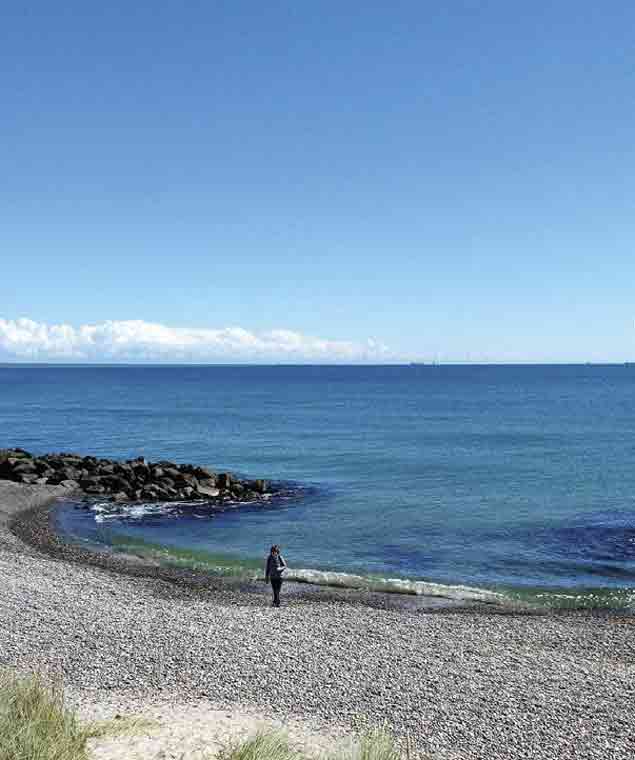 Skagen, where the Skagerrak meets the Kattegat
Skagen, where the Skagerrak meets the Kattegat
Exiting Sweden the southwest wind hardened, we close hauled in an exhilarating 45mile sail across the Kattegat holding the course to Skagen, Denmark. It was a vibrant town with many examples of Danish design and a reputation for art and artists. If the art was current, the artists might be ‘helping police with their enquiries’. we visited art galleries and museums. Over the next few days we hired bikes and cycled out to the lighthouse at Grenen beach where the seas of the Skagerrak and Kattegat skirmish. Conscious of the impending North Sea crossing, we watched weather patterns. Yachts waiting many weeks in Norway to cross, had turned south to seek favourable passage. A miracle, the weather began to shift. The original plan to get to westernmost point of Norway and wait was abandoned.
15th August; 11.30 with the barometer at 1020 we sailed west. The swell faded, a red sunset and rising moon herald a splendid night at sea. In the morning, a light westerly returned, we motored all day and through the cold night, the sea was glassy. Next day, oil fields, we pass steel behemoths sucking the residue of long dead microscopic plants and animals. Their stored energy pushing Pylades over their grave. A whale slid by and a pod of white beaked Dolphins visited. There was a stunning sunset as ‘Turner’ reds to the north blend with muted blues and greys to the south, Then Scotland’s version of ‘Tierra del Fuego’ came to life, the huge fire flares of the rigs, welcomed Pylades. Towards dawn a southeast wind picked and we were sailing, later as the wind touched 30 knots, we passed into the relative shelter of the Moray Firth, the wind increased further, hugging the windward south shore we jogged happily along all night under a scrap of headsail.
19th August; at dawn, we entered the snug marina at Inverness, the warm welcome offsets the slightly shabby town, perhaps we had become used to Nordic habitats. Next day we payed £233.00 and entered the Caledonian Canal, magnificent 200-years-old engineering working perfectly. One of the lock keepers remarked, “I have the nicest job in the fairest surroundings one could get”. They helped with the lines and engaged in great discussions on ‘Brexit’ and much else.
 At Neptune’s Staircase
At Neptune’s Staircase
Lough Ness is long, narrow, deep and it funnels the wind on the nose. By 16.00 we walked Fort Augustus where the battle cries of Culloden still echo. The next day, by Loch Lochy’s shore a golden eagle held position in a westerly breeze and we caught our first sight of Ben Nevis.
23rd August; a busy morning descending Neptune’s Staircase to the fine stone basin at Corpach. To the south, the magnificent bulk of Ben Nevis brought great memories of a day spent on its airy ridges. The following morning, we were at sea rushing south on a fair tide through the Corran Narrows. Oban Marina was almost deserted, we ferried to town and stock up, the water at the marina was not recommended but a kindly occupant of Kerrera Island insisted we take 20 litres of bottled water. 04.00 next morning, with the light not yet in the sky we were underway.
There was a cold Autumnal feel to the air as a light wind freshened from the southeast. In a rollicking sail, Islay faded as Malin Head materialised to the south. Seven miles from the entrance to Lough Swilly the wind veered to the southwest and freshened considerably, squalling to 35 knots. We battered our way to the calmer waters of the lough and in darkness and rain felt our way in to Port Salon, assisted by a howling wind we bedded our anchor at 23.15. The morning was fine but blowing hard from the southwest, a lazy day was passed swinging to our anchor, on odd jobs, plotting our jumps home and topping up the diesel tank from cans.
26th August; 06.00 underway in a light south-easterly, the forecast was sympathetic for only a few days, so with regret we passed Tory Island. Donegal Bay was deserted, except for two Spanish trawlers, who, just north of Eagle Rock appeared intent on running us down. With a poled-out Genoa, we ran south in splendid conditions discussing the magnificent headlands and Islands of our coastline. 19.30 on the 28th August we tied a Kilronan and strolled to Tí Joe Mac, for a contemplative pint. A late breakfast with ‘fry up’ we resolved to do little all day, but slowly walk the beaches and make sandcastles.
Tuesday the 30th August, over canvassed and with mixed feelings we had a fast reach east to Kinvara bay and picked up our mooring at Parkmore. The 3800 mile, 109-day voyage to Russia had concluded. We loaded the dingy, outboard and gear into our van. Ashore, we looked out at Pylades, alone on its mooring and with a tear in our eye, drove slowly home.
Hugo Duplessis 1924-2018
Hugo Duplessis was a complete one-off, and his death at the age of 94 brings to an end a lifelong involvement with boats and cruising. Yet everything about him was in a sort of amiable contradiction.
As he’d a decidedly bushy appearance in his prime, with his splendid mop of curly grey hair matched by a strong and unruly beard, you’d have assumed that he would be a natural enthusiast for traditional construction, and boats of archaic rig.
This traditionalist image was accentuated by his approach to time-keeping. Or perhaps his relaxed attitude to precise punctuality was accentuated during the time he spent in Ireland in the 1970s and 1980s, running a cruising yacht charter company - Irish Atlantic Yacht Charters - from Bantry.
However it came about, for Hugo the soft air of West Cork seemed to encourage an already laid-back attitude to everything, and anyone chartering one of his two yachts soon learned that if they didn’t adopt the same leisurely approach, then they weren’t going to get the full value from the experience.
Yet the two ketches he had on charter were the giveaway to the other side of his character. Far from being colourful traditional vessels as some might have expected, they were straightforward glassfibre boats built in no-nonsense style by Westerly Marine – a 36ft Westerly Conway, Samharcin an Iar, and a 32ft Westerly Berwick, Aisling na Mara.
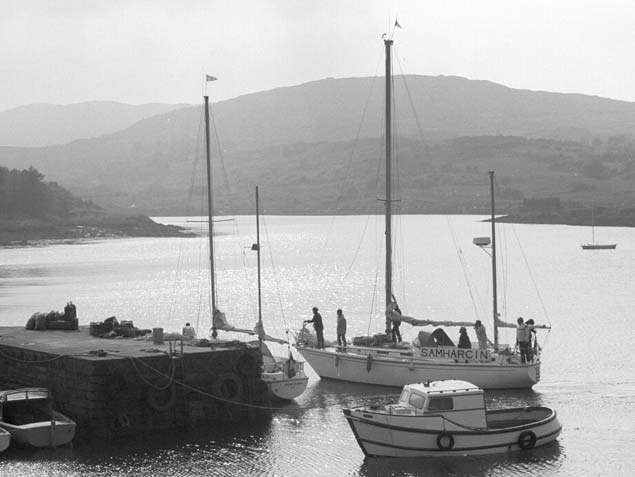 The dream of charter cruising in West Cork – Irish Atlantic Yacht Charters’ two Westerly Marine ketches Aisling na Mara and Samharcin an Iar in Lawrence Cove on Bere Island in May 1982. Photo: W M Nixon
The dream of charter cruising in West Cork – Irish Atlantic Yacht Charters’ two Westerly Marine ketches Aisling na Mara and Samharcin an Iar in Lawrence Cove on Bere Island in May 1982. Photo: W M Nixon
Robustly built and noted as boats requiring minimal maintenance, they were a reminder that in another earlier life in the south of England, the young cruising enthusiast and boat-building experimenter Hugo du Plessis (he underwent a name modification during his nine and more decades on the planet) had been an early enthusiast for glassfibre construction, to which he brought a complete precision which seemed to be lacking in other aspects of his life.
His curiosity and practical research into the full possibilities of the new material resulted in the publication of his authoritative book, Fibreglass Boats, in 1964. It is now in its fifth edition, still an authoritative reference book for building and repairs, and it has achieved continuing success on both sides of the Atlantic.
Yet if you spent time in Hugo’s company cruising in West Cork, it was sometimes difficult to reconcile this easygoing and colourful character with the precise and scientific approach which set the tone of his book. And equally, his obvious enjoyment of the lotus-eating aspects of being in port while cruising were at variance with his quiet determination to complete some extraordinary voyages in which, so long as he had the time that he felt the venture merited, he succeeded with achievements which received full recognition from cruising adjudicators.
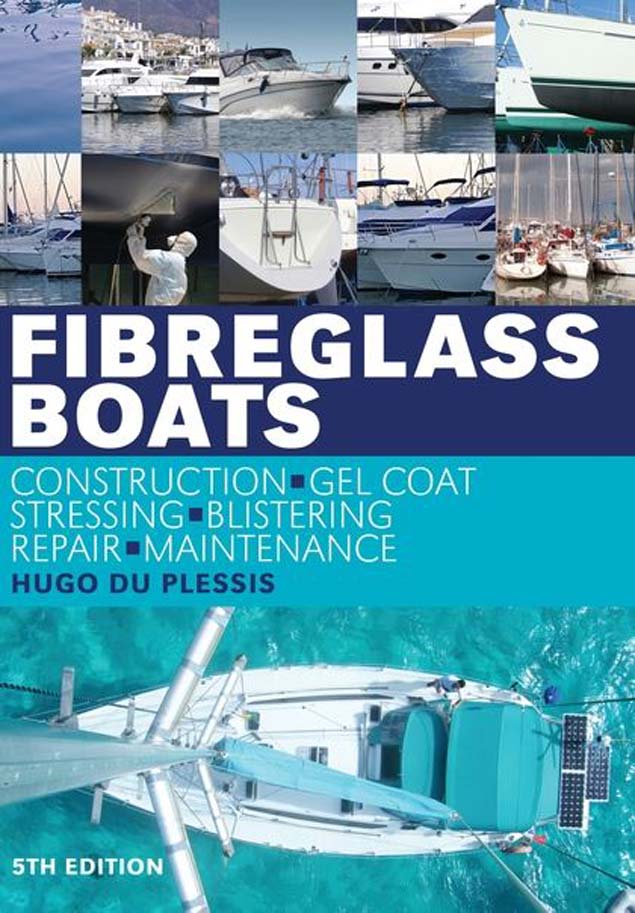 The current 5th Edition of the authoritative Fibreglass Boats by Hugo Du Plessis. It was first published in 1964.
The current 5th Edition of the authoritative Fibreglass Boats by Hugo Du Plessis. It was first published in 1964.
After World War II ended in 1945, Hugo was cruising the English Channel almost before it was permissible, as live minefields were still present. But he survived this hazard, and by 1947 had been elected a member of the Royal Cruising Club, with which he was to be awarded six major cruising trophies before he made his move to Ireland.
Once here, he became a member of the Irish Cruising Club in 1978, and when he finally wound down his yacht charter business, he kept the 36ft Westerly Conway Samharcin an Iar for his own use, and most appropriately headed west. While the whole Atlantic was available to him, and he crossed it several times, it was the less-visited cruising areas which inevitably attracted him, and a detailed cruise of Venezuela in 1996 saw him being awarded the ICC’s premier trophy, the Faulkner Cup, while previously he’d collected the same club’s Atlantic Trophy in 1986 and the Strangford Cup in 1988.
He continued active ocean cruising until well into what other people would have though of as old age, but eventually he returned to base and home in Lymington by the Solent. However, he was a boat-owner to the end, co-owning a Colvic 23 Crimson Rambler III with his daughter Prim. He was seen afloat in this characteristically sensible little boat as recently as September last year. A remarkable man – our thoughts are with his family and friends.
WMN
The award during February of the Irish Cruising Club’s premier trophy - the Faulkner Cup - to Maire Breathnach of Dungarvan was another highlight in a remarkable cruising career. The trophy was for the voyage she made with her husband Andrew Wilkes in their 64ft gaff cutter Annabel J to northeast Greenland. Its award made her a worthy Afloat.ie February “Sailor of the Month (Cruising)”, and also served to highlight her outstanding cruising and voyaging experience. She first came to notice with a mostly single-handed round Ireland cruise with a Hurley 22, and since teaming up with Andrew Wilkes she has circumnavigated both South America including Cape Horn, and North America via the Northwest Passage, in all a very impressive CV.
 The 64ft steel-built gaff cutter Annabel J which Maire Breathnach and Andrew Wilkes cruised to northeast Greenland
The 64ft steel-built gaff cutter Annabel J which Maire Breathnach and Andrew Wilkes cruised to northeast Greenland
Irish Sailing’s Cruising Conference was a Kaleidoscope of Information, Inspiration, Entertainment & Camaraderie
The day-long Irish Sailing/Cruising Association of Ireland Annual Cruising Conference, organised with energetic enthusiasm by Irish Sailing’s Gail MacAllister, deservedly attracted a full house on Saturday to the Clayton Hotel in Leopardstown in South Dublin writes W M Nixon.
A motorway-focused modern hotel may seem an unlikely setting for a gathering redolent of sailing the salty sea. So it tells us everything about the calibre and variety of the speakers and presenters, and the range of their subjects, that the audience very quickly felt that they were no longer in a window-less conference suite. Instead, they were magically transported to a maritime environment, in and around boats among fellow-minded shipmates either simply enjoying cruising, or dealing with its challenges, or indeed solving the many sometimes apparently intractable problems which come with owning and running a boat.
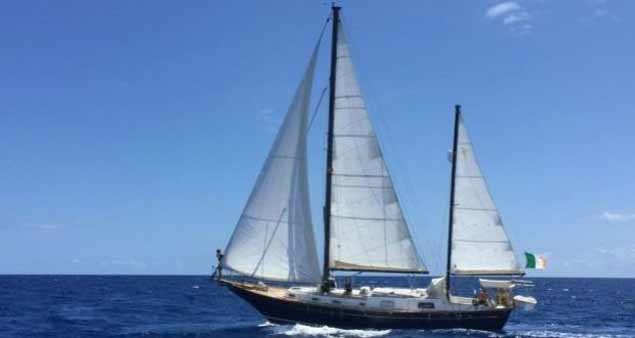 Rogue Trader – with much TLC, she became a dream-fulfilling ocean voyager
Rogue Trader – with much TLC, she became a dream-fulfilling ocean voyager
There was no mistaken attempt to give the impression that real cruising is easy - that it is simply racing without the stress. On the contrary, the conference started with Claire McCluskey and Nick Russell’s inspiring story of how - virtually on a whim – they bought the hefty and decidedly tired ketch Rogue Trader – 56ft from the end of her mizzen boom to the tip of her bowsprit – restored her to full seaworthiness, and then headed off on an Atlantic cruise which has seen 10,000 nautical miles logged. Just like that……..
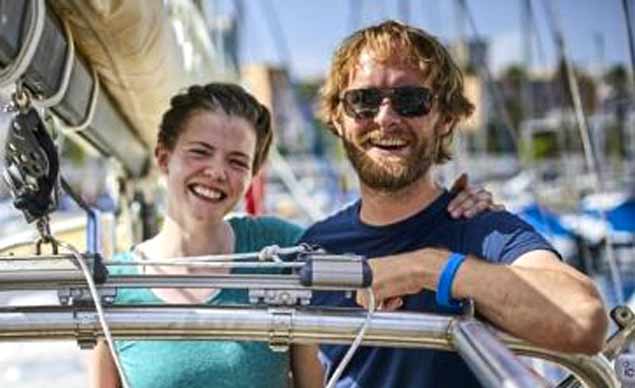 Claire McCluskey and Nick Russell – a spur-of-the-moment decision became a dream of the future, and the dream came true
Claire McCluskey and Nick Russell – a spur-of-the-moment decision became a dream of the future, and the dream came true
It was very hard work making it happen for Rogue Trader, but once she was actually under way it was mostly fun. So, for balance, the next topic was not fun at all - the pollution of our seas and coastlines, particularly by plastic. The speaker was Sinead McCoy, Coastal Communities Manager with An Taisce, and though in spreading environmental awareness in the cruising community she was largely talking to the converted, it is our duty to pass on the message, particularly as regards plastic, for it seems that some forms of it actually have a taste which is attractive if ultimately fatal for marine life.
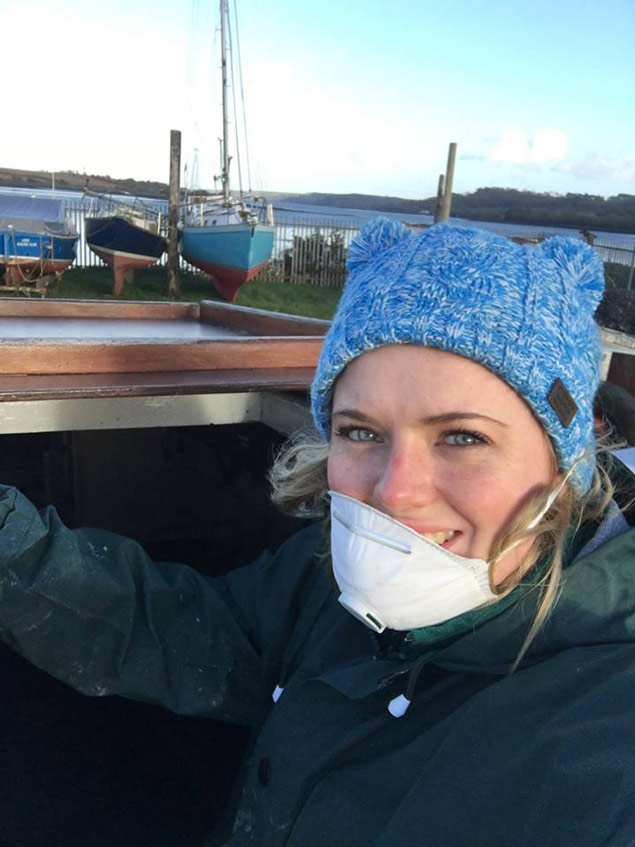 Evie Conway has taken on a massive wooden boat restoration job.
Evie Conway has taken on a massive wooden boat restoration job.
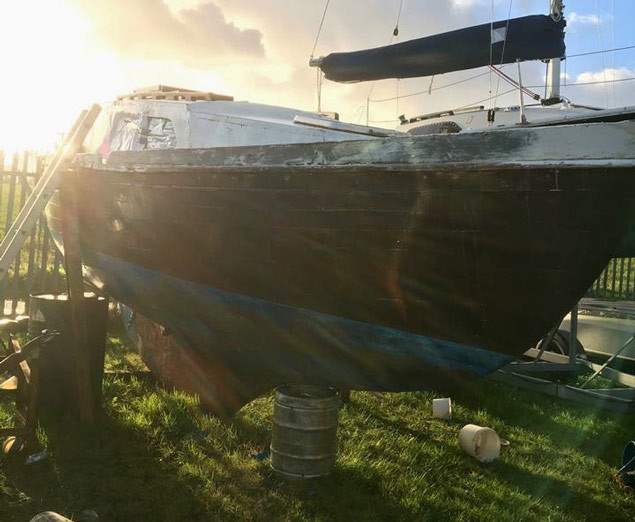 Urgently in need of restoration – very little is known of the origins of Evie Conway’s 26-footer, but by the time the restoration job is completed in her parents’ garden, it is hoped the entire history will be available.
Urgently in need of restoration – very little is known of the origins of Evie Conway’s 26-footer, but by the time the restoration job is completed in her parents’ garden, it is hoped the entire history will be available.
A serious tone, but with a hopeful longterm outcome, was the theme of the next topic, the restoration project being carried out on a neglected and anonymous 26ft sloop – now called Saoirse – by Evie Conway. At the moment she’s doing the work by herself, but hopes to speed up progress when the boat is moved from Cobh to her parents’ garden in Dublin. In time we’ll hope to have more precise details of the presently-unknown history of this Folkboat-like mahogany-built craft, but for now the project is powered by the extra goodwill generated in Leopardsown.
After that, we were into a presentation which could comfortably have filled the entire morning or afternoon. To describe Alex and Daria Blackwell of Clew Bay as “Atlantic veterans” is a real understatement. Their handsome Bowman 57 Aleria has crossed the Western Ocean many times in a wide variety of conditions, and Alex has taken on what many would describe as the most challenging ocean of them all several times in other vessels, so their Atlantic experience has few rivals.
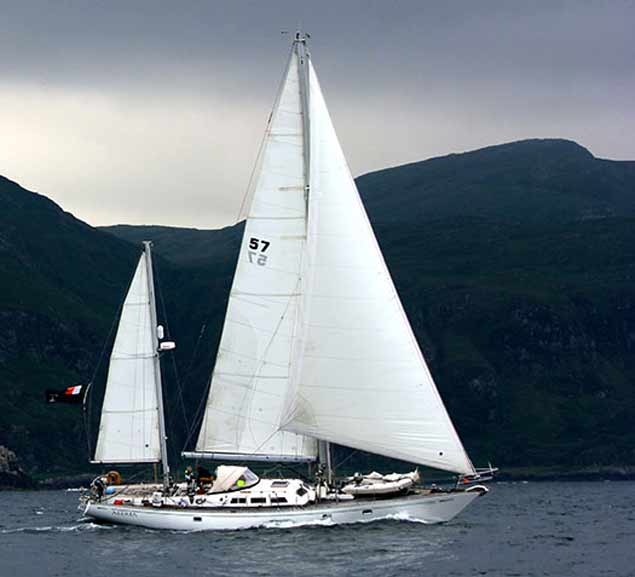 Alex and Daria Blackwell’s much-travelled Bowman 57 Aleria is based in Clew Bay
Alex and Daria Blackwell’s much-travelled Bowman 57 Aleria is based in Clew Bay
But few if any with comparable experience have tabulated their thorough research and knowledge with the dedication of Aleria’s crew. It was an extremely focused yet broad-ranging presentation about how to deal with offshore storms in crossing the Atlantic and everything – but everything – that it might throw at you.
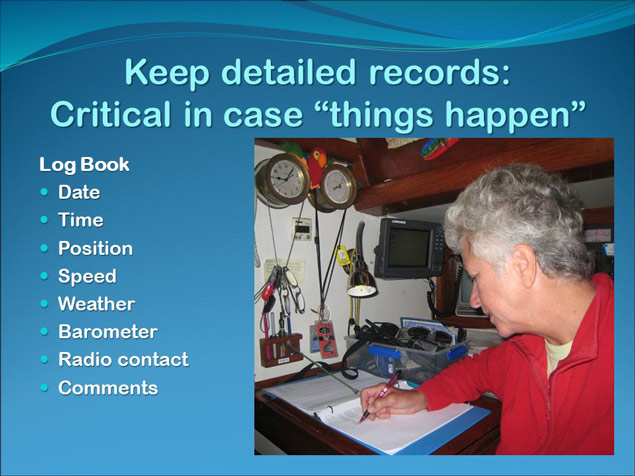 Daria Blackwell aboard Aleria. Even with today’s domination by electronics, it is still vital to keep proper records
Daria Blackwell aboard Aleria. Even with today’s domination by electronics, it is still vital to keep proper records
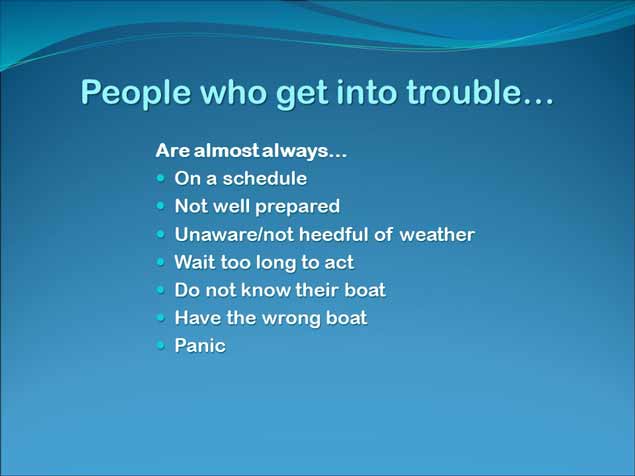 The basic findings by Aleria’s experienced crew
The basic findings by Aleria’s experienced crew
And though Atlantic crossing was beyond the experience or even the ambitions of many present, there was one abiding message of good sense which remained with all who heard it. When the going is getting rough to extremely rough, even if your boat is still making progress, give a thought to the benefits of heaving-to.
Proper heaving-to, that is. Not simply hauling down the sails and lying a-hull – that can be extremely uncomfortable and downright dangerous, for most modern boats lie beam on, the motion is abominable, and there’s a real chance of being completely rolled.
But properly hove-to (and it should be on starboard tack), with a scrap of headsail aback and enough mainsail, try-sail or mizzen set so that you’re lying at the proper angle to the seas, and you’ll find that life on board is transformed. The good sense of this struck a chord with the audience, with one experienced cruising man remarking that if the wind was more than Force 6 – and sometimes much less, depending on the sea state - he always hove-to at meal times.
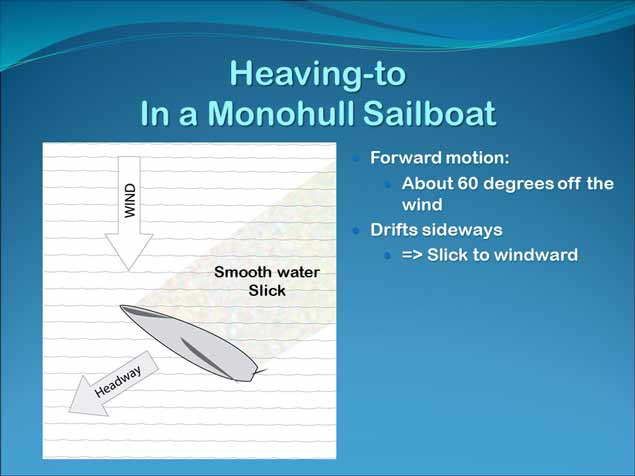 Heaving-to is traditionally done on starboard tack – carried out like this, in theory you then have right-of-way over every other ship except a lightship. And the corollary is that the galley should be on the port side……
Heaving-to is traditionally done on starboard tack – carried out like this, in theory you then have right-of-way over every other ship except a lightship. And the corollary is that the galley should be on the port side……
There was so much thought-inducing material in the Blackwell’s presentation that it took a real mental re-set to adjust to the next item, a maritime poetry reading by Seamus Harrington. But he’s such an engaging reader with so much delight in the topic that it put everyone the mood for lunch, and when your correspondent found himself sharing a table with Daria and Alex Blackwell, Paddy Barry, Alan Leonard and John Duggan of the Irish Cruising Club, there was a possibility that an alternative mini-conference might get underway, but we returned to the conference suite and soon were back to sea, for the afternoon had much more of interest.
John Leahy and Clifford Brown of the Cruising Association of Ireland told us of their organisation’s busy plans for the season of 2018, and then Aodhan FitzGerald of the Marine Institute in Galway, a keen offshore sailor himself and the MI’s Research Vessel Manager, outlined the many problems and solutions in maintaining Ireland’s extensive Marine Weather Buoy Network.
It was a forceful reminder of the fact that Ireland is very much on Europe’s ocean frontier, and that the wave power we’re told is going to provide so much energy in future can also be a destructive force which makes the informationally-valuable buoyage network a constant maintenance challenge, but Aodhan took us clearly through the development of the system, and introduced us to the next generation of equipment.
The final speaker was a double bill, and as it was Norman Kean, Honorary Editor of the Irish Cruising Club Sailing Directions, his contributions were a reminder of just how much difference congenial cruising couples make to our sport. After all, the night before in Dun Laoghaire, we’d seen Maire Breathach be declared the latest awardee of the Irish Cruising Club’s senior trophy, the Faulkner Cup, and that was for a cruise she’d made to northeast Greenland with her husband Andrew Wilkes in their 64ft cutter Annabel J.
Then to start Saturday’s conference, we saw positive couple power demonstrated again in the achievements of Claire McCluskey and Nick Russell. Soon after that, we had the comprehensive contribution of Daria and Alex Blackwell. And here we were, rounding out the day with many insights from Norman Kean, whose wife Geraldine Hennigan is his constant shipmate and effectively co-editor of the Sailing Directions. So the old saying is true: “If you find a good crew – marry her…..”
Norman’s first contribution was on the infrastructural developments around the coast of benefit to cruising folk, and it was heart-warming to feel the sense of pride when somebody’s favourite harbour or anchorage came up on the screen with some really useful new amenity.
 Norman Kean – the man to go to if you want sound advice on marina locations. And a man with a serious message about fishing gear markers
Norman Kean – the man to go to if you want sound advice on marina locations. And a man with a serious message about fishing gear markers
That said, with his unrivalled experience, Norman Kean’s opinion carries real weight, and while you could sense the approval in the room as he showed the welcome new developments at North Harbour at Cape Clear in the far south of the country, equally we shared his sorrow rather than anger that so much public money had been squandered in trying to create a pontoon facility at Bunagee Pier on Donegal’s Culdaff Bay in the far north of the country. It’s a very useful passage anchorage, but without huge – as in really enormous - harbour works, there’s no way it could ever properly shelter pontoons.
Inevitably these comparisons between facilities contributed to the post-conference chat which almost inevitably led to people naming their favourite anchorage, but before we got to that safe haven, Norman has a serious topic to deal with – the marking of fishing gear as in lobster, crab and whelk pots. Salmon nets may have gone, but there seem to be more barely-marked pots around than ever, and there’s now a very determined campaign afoot to have them properly marked with a flag on a pole, with the buoy showing the name of the owner, not just a number or the name of some boat.
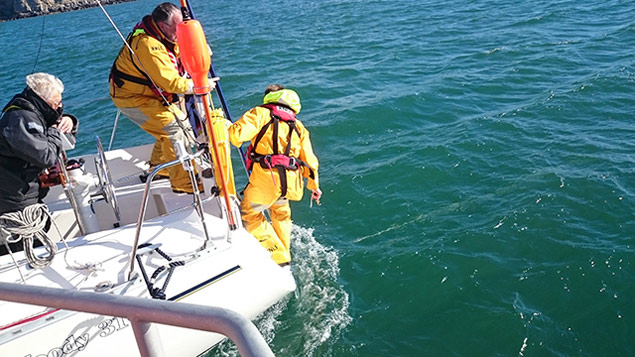 Unseen fishing gear fouls a propeller – not just a day ruined, but you could be in danger, and it might ultimately prove expensive too.
Unseen fishing gear fouls a propeller – not just a day ruined, but you could be in danger, and it might ultimately prove expensive too.
You don’t have to be under power to get fouled in semi-submerged fishing gear, but it greatly increases the risk, and with propeller installations on P-brackets or sail-drive, the hazards are even further compounded. Norman and Geraldine had profound personal experience of this a couple of years ago when they were heading west under power in their 40ft Coire Uisge in the west part of Bantry Bay under the north shore. Although they gave a barely visible marker buoy a good berth, a second invisible buoy was some distance away on a semi-submerged line, and with a sickening clunk they were immobilised.
The wind and set of the seas was basically onshore, and it soon became apparent that although out of control, they were slowly dragging the now multiply-tangled set of pots towards the lee shore. So a Pan Pan call became the only option, and the Castletownbere lifeboat the ultimate solution – plus about €2,000 to put right the damage to the propellor installation.
Norman Kean – one of the most experienced and safety-conscious cruising people you could ever hope to meet – was completely frank about having to seek help. But being of a positive outlook on life, he kept a complete record of the entire experience, and now he is a leading figure in the international movement to make the marking of floating or semi-submerged fishing gear a much more effective business.
 The date is already set for next year’s conference
The date is already set for next year’s conference
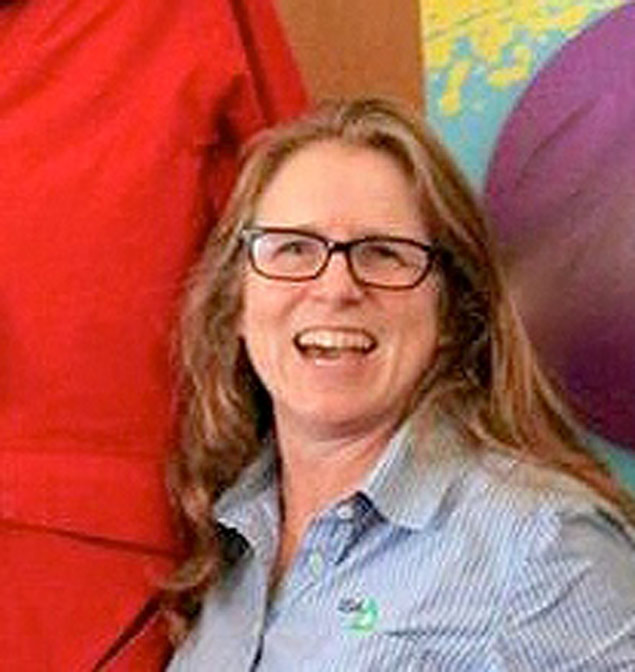
Gail MacAllister – she’ll be doing well to match the content quality of 2018’s conference
It was a thoughtful note on which to end, but then it was one very thought-provoking conference throughout. So much so, in fact, that people were in no hurry to leave, for it’s seldom enough that you’ll get such a centration of genuine cruising enthusiasts in one place with the day devoted to their favourite subject. The date and venue has been set for 2019’s conference already – it’s Saturday February 16th at Lough Ree Yacht Club near Athlone. Gail MacAllister will be doing well to match the calibre of her 2018 lineup. But for now, very well done to everyone involved in this year’s event.
 Good wishes from Aleria to send everyone safely on their way
Good wishes from Aleria to send everyone safely on their way
Purchase a copy of Alex and Daria Blackwell's Cruising the Wild Atlantic Way here.
Irish Cruising Tops Weekend Agenda
Irish cruising under sail and power is being celebrated and developed this weekend. Last night’s AGM of the Irish Cruising Club in the National YC in Dun Laoghaire saw this 1929-founded organisation moving its many activities forward on all fronts while also distributing its annual awards – some of which date back more than 85 years – to honour a range of remarkable seagoing achievements.
And today, Irish Sailing’s Annual Cruising Conference - with the involvement of the Cruising Association of Ireland – is taking place in the larger venue of the Clayton Hotel in Leopardstown in south Dublin, a day-long information-packed gathering which is providing an unrivalled selection of expert topics and informed discussion groups in an atmosphere which evokes the special camaraderie of the sea. W M Nixon casts an eye over the current Irish cruising scene.
The interesting and attractive harbour town of Dungarvan in West Waterford would not be the first place that springs to mind when thinking of major sailing achievement. While it has a busy sailing club with a welcoming in-harbour pontoon for visitors and locals alike, much of the anchorage in the inner harbour dries, and the entrance channel from Dungarvan Bay requires careful negotiation.
Yet last night in Dun Laoghaire, the two top trophies in the Irish Cruising Club’s historic list both went to Dungarvan sailors.
The Faulkner Cup, which dates back to 1931, and the Strangford Cup, which was presented many years ago as an alternative to the Faulkner Cup when that season’s adjudicator couldn’t make up his mind when choosing between two superb cruises, will both be at home for the next year in Dungarvan, on display in that south coast town where the Comeragh Mountains and the Colligan River come to the sea at the broad east-facing bay in the lee of the Ring Peninsula.
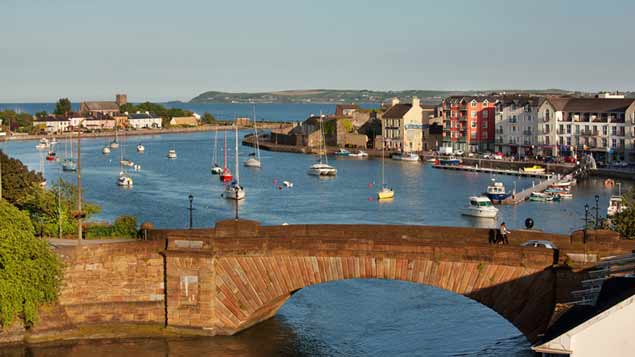 Dungarvan Harbour at high water. Despite the fact that much of the anchorage dries, the hospitality makes it a popular port of call
Dungarvan Harbour at high water. Despite the fact that much of the anchorage dries, the hospitality makes it a popular port of call
Not only that, but these remarkable award-winning sailors are sister and brother. And both their cruises in their respective boats were to the Arctic. To go north when your home port faces south, and has ancient trading links with France and most especially Spain, takes some extra determination.
Particularly so as Maire Breathnach, awarded the Faulkner Cup, and her brother Donal Walsh - who now holds the Strangford Cup - are the children of the late Gerry Walsh, a pioneer of Dungarvan sailing development, who was a junior crewmember on the only Dungarvan cruising boat of note in the 1950s, Reveille Farrell’s powerful 34ft 1936-built Bermudan cutter Susanna.
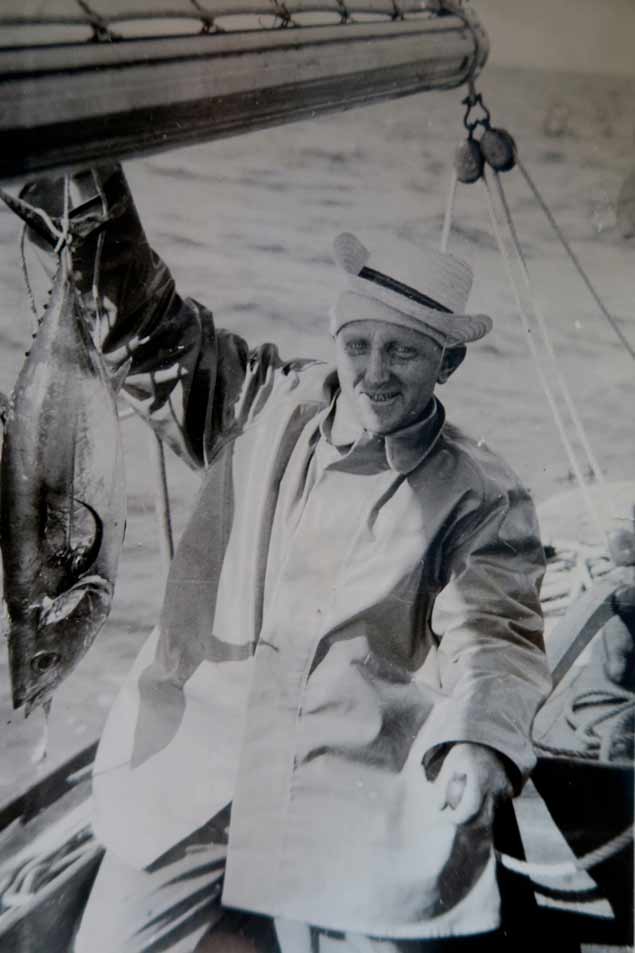 Gerry Walsh with some successful fishing aboard Susannah in 1957
Gerry Walsh with some successful fishing aboard Susannah in 1957
Susanna was later to acquire added distinction by winning the 1961 RORC Beaumaris to Cork Race under the ownership of National YC Commodore John McConnell. But in 1957 while still Dungarvan-owned, she cruised to Spain and back with the young Gerry Walsh on board, and family memories of that then-considerable venture have propelled the new Walsh generation on to stratospheric heights of seagoing achievement.
Donal built his reputation for some time with extensive cruising with the Moody 31 Lady Kate, while Maire – having started by cruising round Ireland single-handed in a Hurley 22 – then teamed up with Andrew Wilkes from the south of England, and they cruised round South America in the Swan 44 King of Hearts in 2004, an epic voyage which saw Maire being awarded the ICC’s Faulkner Cup for the first time.
Maire and Andrew married un due course, by which time they were sailing a very different boat – the steel-hulled gaff yawl Young Larry, a robust replica of an Edwardian cruising yacht with which they circumnavigated North America, Northwest Passage and all, and for this they were given the ICC’s supreme international accolade, the occasionally-allocated Fastnet Award, in 2014.
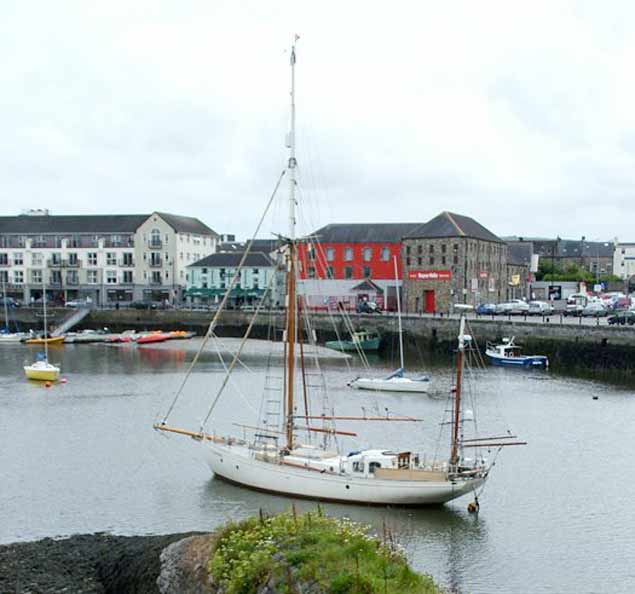 Young Larry over-wintering in the pool immediately below the bridge at Dungarvan
Young Larry over-wintering in the pool immediately below the bridge at Dungarvan
At home, Young Larry could just fit into the pool beneath the bridge at Dungarvan for a winter berth, but when they moved on to their current boat, the powerful 64ft steel gaff cutter Annabel J which is broadly a development of the Bristol Channel Pilot Cutter type, they found that her sheer size meant they had to use the Waterford City Marina – an hour or so up the road – as the winter berth.
Despite the massive nature of Annabel J’s gear and sails, there are times when this remarkable couple cruise quite extensively with just the two of them on board. And even when they are joined by sailing friends and relatives, Annabel J is never over-crewed.
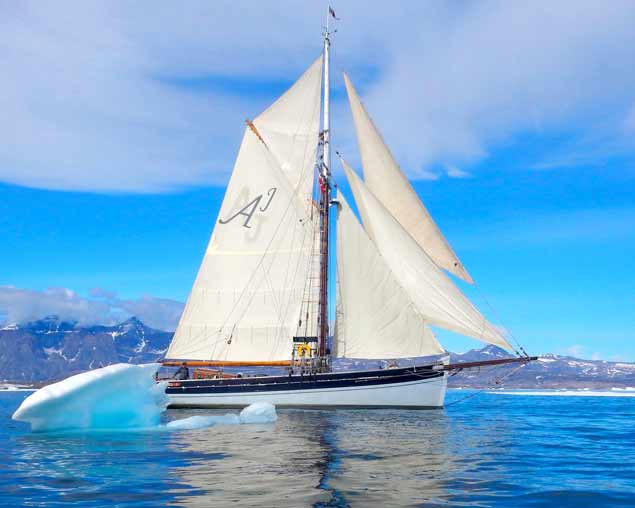 The 64ft Annabel J – quite a proposition for a crew of two, a real test of skill and experience.
The 64ft Annabel J – quite a proposition for a crew of two, a real test of skill and experience.
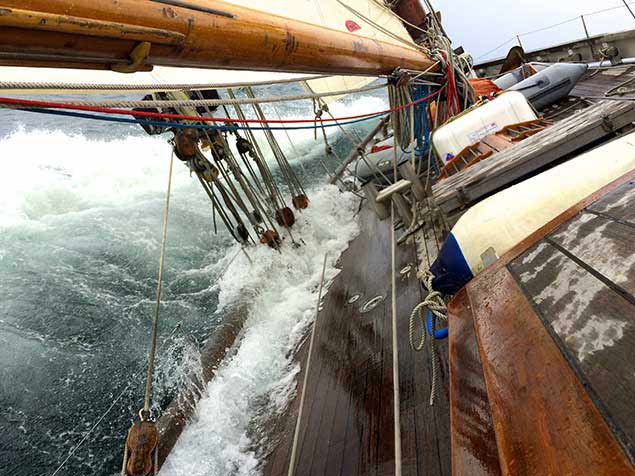 Traditional sail - Annabel J developing full power
Traditional sail - Annabel J developing full power
But she and her gallant sailors certainly do the business, for in 2017 they cruised north first to Iceland, and then on to Scoresby Sund in northeast Greenland before returning south westward of Iceland to complete a circumnavigation of that dramatic land, and on the way home in Westmanna – a place of historic Irish associations – they met up with brother Donal doing a “simple” round Iceland cruise with his alloy-built Ovni 385 Lady Belle which, thanks to its lifting keel, can comfortably berth where wished back home in Dungarvan.
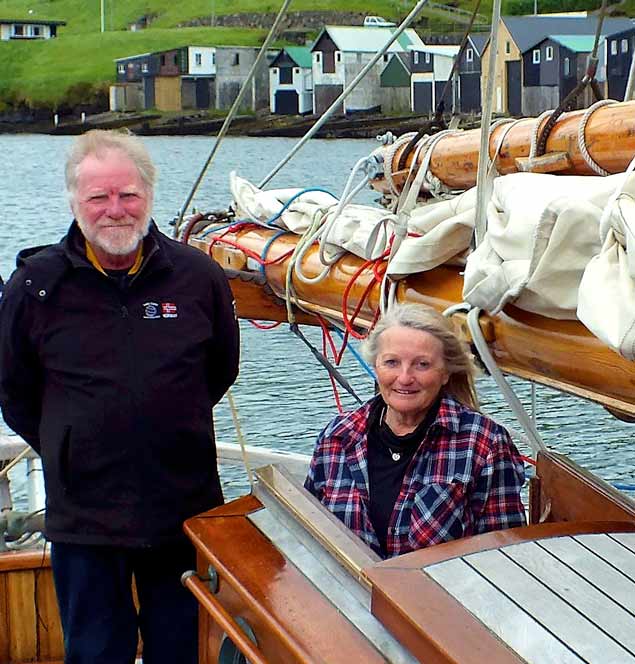 The seafaring children of Gerry Walsh – Donal and Maire met aboard Annabel J in Westmanna in Iceland
The seafaring children of Gerry Walsh – Donal and Maire met aboard Annabel J in Westmanna in Iceland
Both boats then returned to Dungarvan via the west coast of Ireland, so round Iceland and round Ireland circuits were part of the two projects, and on Lady Belle they even managed to take in a sighting of Rockall while homeward bound, a surprisingly small rock pinnacle which admittedly is more easily found with the latest SatNav gear.
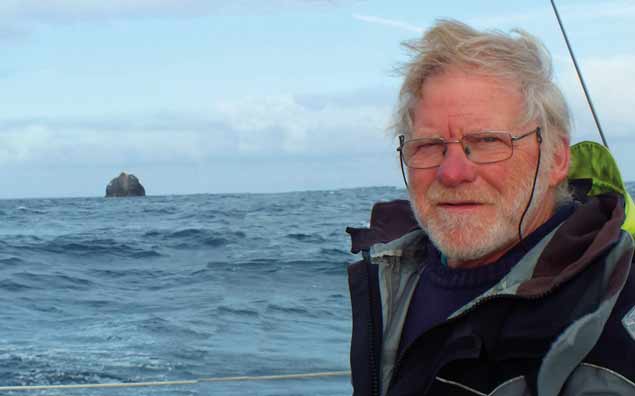 Donal Walsh takes his Ovni 385 Lady Belle past the elusive pinnacle of Rockall on passage from Iceland to the West Coast of Ireland
Donal Walsh takes his Ovni 385 Lady Belle past the elusive pinnacle of Rockall on passage from Iceland to the West Coast of Ireland
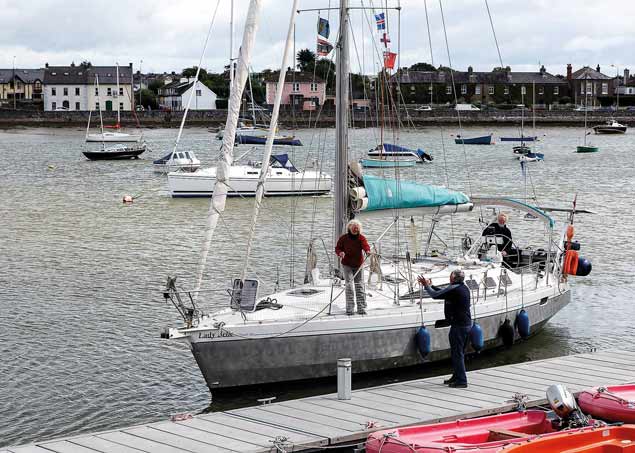 Lady Belle is welcomed back to the Pontoon in Dungarvan on her return from Iceland, Donal Walsh on the helm, and Clare Morrissey on the foredeck
Lady Belle is welcomed back to the Pontoon in Dungarvan on her return from Iceland, Donal Walsh on the helm, and Clare Morrissey on the foredeck
The season over, Maire’s work was only starting, as she had voluntarily taken on the Honorary Editorship of the Irish Cruising Club Annual, which her predecessor Ed Wheeler had raised to fresh heights of quality during his five years in the job. The new Edition, Maire’s first and covering the 2017 season, is a superb production, and it was comfortably with the membership at home and abroad in time for Christmas. But it was only last night in Dun Laoghaire that the annual awards could go fully public, as the annual distribution of prizes is now the concluding highlight of a very crowded and busy gathering.
It’s a gathering which reflects the truly all-Ireland nature of the club, which was one of its central aspirations when it was founded with an assembly of five cruising yachts at Glengarriff in July 1929. The current Commodore, Stanton Adair, cruises from Bangor on Belfast Lough. The Honorary Editor of the Journal, Maire Breathnath, is in Dungarvan. The Honorary Secretary, Alan Markey, sails from Howth. The Honorary Editor of the Irish Cruising Club Sailing Directions – which cover the entire coast in two continually-updated volumes – is Norman Kean, who cruises from Courtmacsherrry on the south Cork coast and is comprehensively supported in his efforts by Geraldine Hennigan. And the Honorary Awards Adjudicator for 2017 was Derek White, who cruises from Strangford Lough in a Fastnet 34 which was built in Limerick. So when we talk of an “Irish” Cruising Club, we really do mean it in the broadest sense.
And of course although Derek White chose to give the two main prizes to cruises to the High Arctic, there were many other extensive ventures to warmer places, although another noted high latitude project was the cruise to Svalbard by Michael and Ann Madsden of the NYC in Dun Laoghaire with their Starlight 35 Gabelle, for which they were awarded the Rockabill Trophy for Seamanship.
In complete contrast to all these icy wanderings, the ICC’s core organized event in 2017 was the Rally in the Rias of Northwest Spain in July. Organiser Peter Haden of Ballyvaughan in County Clare and his team thought they might get as many as thirty boats. But it proved so popular they had to cap the number at sixty.
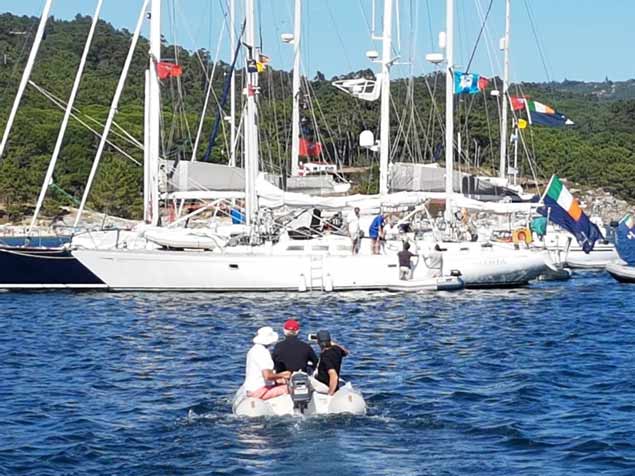 Fleet assembly during the ICC Rally in Galicia. In the foreground is Alex and Daria Blackwell’s Bowman 57 ketch Aleria from Clew Bay, and they’ll be speaking this afternoon about their ocean-sailing experiences at the Irish Sailing Cruising Conference. Photo Tansey Millerick
Fleet assembly during the ICC Rally in Galicia. In the foreground is Alex and Daria Blackwell’s Bowman 57 ketch Aleria from Clew Bay, and they’ll be speaking this afternoon about their ocean-sailing experiences at the Irish Sailing Cruising Conference. Photo Tansey Millerick
And an extraordinary selection they were too, coming from every direction, for the ICC now operates in an international way. So not surprisingly some of the cruises to get there were award-winning in themselves, a good example being by Portuguese-based John Duggan with his Castro 40 Hecuba, winner of the Strangford Cup in 2013. He’d a crew of all the talents with Daragh Nagle (winner in 2016 Faulkner Cup for his extensive Pacific islands cruise with his West Canada-based Moody 376 Chantey V) and that noted Dun Laoghaire sailor Ailbe Millerick.
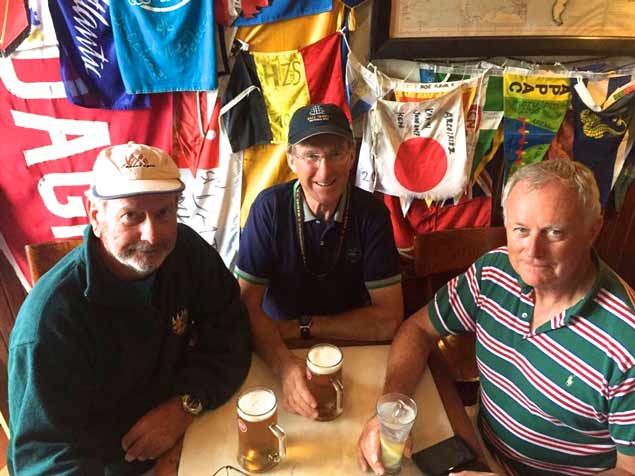 Seasoned ocean voyagers – Hecuba’s crew of Ailbe Millerick, Daragh Nagle and John Duggan in the legendary Peter’s Bar in Horta in the Azores.
Seasoned ocean voyagers – Hecuba’s crew of Ailbe Millerick, Daragh Nagle and John Duggan in the legendary Peter’s Bar in Horta in the Azores.
Ailbe hadn’t contributed to the ICC Annual before, so he was detailed off to tell how Hecuba got to the Spanish Rally from Cascais by first sailing out to the Azores, cruising those islands in some informative detail, and then shaping their course back to join the party. He tells the story so well that Hecuba and Ailbe Millerick are awarded the Perry Greer Bowl for the best first log, and as for the party in Spain, it was epic.
Most of us cannot even begin to guess at the level of background work which is needed to cater for the needs of 60 boats (many of them quite substantial craft) and their decidedly diverse crews as they make their way from one choice port or anchorage to another along one of Europe’s premier cruising grounds. So very deservedly Peter Haden was last night honoured with the Aran Islands Trophy of the ICC’s Western Committee for his quietly brilliant work in putting this marvellous happening together.
The accounts of its crowded events in the Annual are in total contrast to another log which Maire Breathnath has included in what she hopes will be a feature of future Annuals, a log from the archives. She has started it off in style with the story of her father and his shipmates from Dungarvan sailing the Susanna out to northwest Spain and back in 1957, and it perfectly captures the atmosphere of 61 years ago, when the world was very different, and boats were very different too, but the spirit of cruising was essentially the same.
 As it was then – Reveille Farrell’s 34ft Susanna from Dungarvan in northern Spain in 1957
As it was then – Reveille Farrell’s 34ft Susanna from Dungarvan in northern Spain in 1957
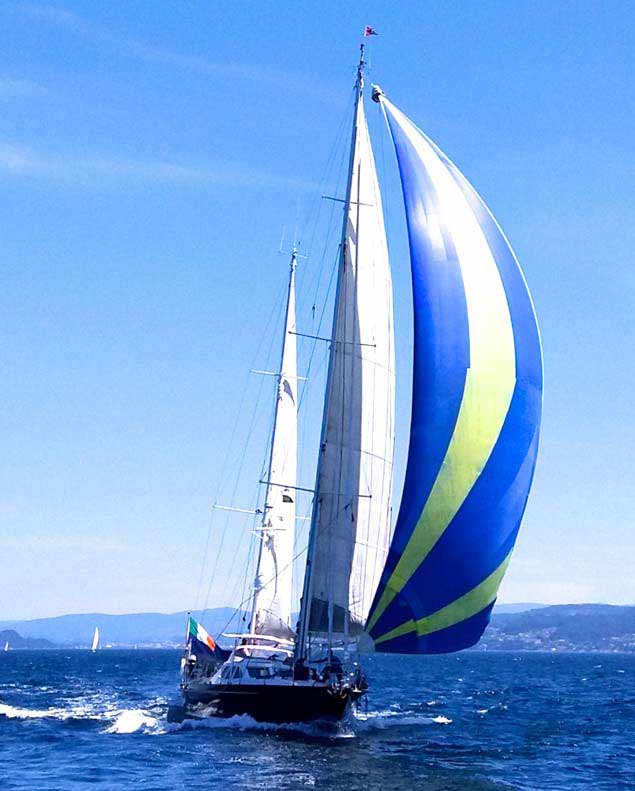 As it is now – Michal Holland’s 70ft ketch Celtic Spirit in in the ICC Rally, July 2017. Photo: Trish Phelan
As it is now – Michal Holland’s 70ft ketch Celtic Spirit in in the ICC Rally, July 2017. Photo: Trish Phelan
Of course, not all the logs in the 200-page Annual are about distant ventures, and with 13 awards for cruising, the Honorary Adjudicator is spoilt for choice. But one which continues to be very special for the ICC is the Round Ireland Cup, and for 2017 it goes to Alan Leonard of Strangford Lough, whose elegant circuit with the Starlight 35 Ariadne was gently made in detail by not actually declaring that he was on a clockwise round Ireland cruise until be noticed that his home port was nearer if he just kept gong the way he was, calling at many interesting places along the way.
At one of them, Rutland Harbour near Burtonport in Donegal in July, he met up with Charlie Kavanagh of Wicklow in his Sadler 34 Stravaiger, likewise on a leisurely round Ireland cruise, but this time anti-clockwise. Alan asked him when he hoped to get home. “October” said Charlie. Now that definitely is cruising.
Other definitions and aspects of cruising will be part of today’s busy agenda at the Irish Sailing Cruising Conference in the Clayton Hotel in Leopardstown in Dublin. There’s a comprehensive all-day programme, and the interaction between the various organisations in cruising is reflected by the fact that the speakers include the ICC’s Norman Kean from Courtmacsherry, together with another ICC couple, Alex and Daria Blackwell from Clew Bay, while a third speaker, Galway’s Aodhan FitzGerald who is Research Vessel Manager with the Marine Institute, is likewise ICC.
Norman Kean and Geraldine Hennigan’s devotion to furthering cruising knowledge was neatly indicated in 2017 when they located their 40-footer Coire Uisge in northwest Spain well in advance of the ICC Rally, as they felt the available sailing directions were inadequate for some of the more detailed channels. As a result all participants were presented with crisp new ICC-quality directions filled with local knowledge which enabled them to take some very interesting routes.
However, Norman’s two presentations this afternoon are on New Developments in Infrastructure, which will provide real inside track material, as he’s a fellow of the Royal Institute for Navigation, while his second talk will be a real cry from the heart, as he’ll be moderating an open discussion on obstructive Fishing Gear.
His boat Coire Uisge experience a total and expensive foul up with submerged lobster gear a couple of seasons ago, so we can expect a detailed and heartfelt Norman Kean exposition and proposals for improvement in classic style.
As for Alix and Daria Blackwell, they’re also leading figures in the Ocean Cruising Club, and their experience of rough ocean weather with their Bowman 57 Aleria and other craft is extensive and varied. But sometimes it’s far from blissful. In the rough Atlantic weather of July 2016, Alex sustained broken ribs while helping a friend deliver a substantial American yawl from the Azores to Ireland, so even home runs can sometimes prove to be distinctly other than a cakewalk.
Certainly by the time the conference closes by 5.0pm this evening, we can expect to have taken on board some real quality information on the current state of Irish cruising. The knowledge is undoubtedly there, and organizer Gail MacAllister of Irish Sailing has provided the means of tapping into it.
Galway Bay Sailor Dave FitzGerald Celebrates the Big Nine-0
His many friends in international sailing and the global mining industry will be delighted to hear that the legendary Dave FitzGerald celebrated his 90th birthday at a very convivial gathering of family and close friends in the Royal St George YC in Dun Laoghaire at the weekend, hosted by his daughter Grainne writes W M Nixon.
Dave FitzGerald is best known as a legend of west coast and particularly Galway Bay sailing, but these days he lives in Dublin to be near his daughters, and old shipmates from the west coast came across country to join the great man as he entered his tenth decade.
His careers in mining and sailing - and indeed sports generally - are all decidedly high-powered. He is renowned for his utter fearlessness in the hunting field, and he brought the same total enthusiasm to his sailing. When he owned the 40ft sloop Partizan in the early days of the Round Ireland Race, he was a committed supporter of this new event starting and finishing in Wicklow. This meant that in order to participate, Partizan had to sail round Ireland twice, but it was the sort of thing the great men and women of west coast sailing could take in their stride.
When sailing took over from hunting for the summer season, if not racing he would go cruising – sometimes very extensively - and he was a popular member of the Irish Cruising Club, elected in 1966. In those days, cruising boats were few and far between on the Atlantic seaboard, but Dave encouraged others to take part in a sport which is now thriving in that challenging area. Meanwhile, he became part of the ICC administration, moving up through the committee and various offices until on the advent of the new Millennium in 2000, he became the ICC’s first Commodore from the west, hosting many memorable events.
Dave FitzGerald’s long and very active life has encompassed several eras of sailing, and seen many changes in design and boat use. When he returned to Ireland after very impressive experiences in some extraordinarily remote mining operations in many parts of the world, it was to develop Tynagh Mine near Loughrea in County Galway. Having decided that the area would be his longtime base of operations, and that Galway Bay would be his new sailing home, he bought his first cruiser in Dun Laoghaire, a little Snapdragon 26 which he called Pegeen.
Being impatient to start sailing in Galway Bay as soon as possible, he researched the best way of having the new boat delivered across country, and discovered that owing to some clerical oversight, the freight rate charged by CIE Rail for such a boat from Dun Laoghaire station to Galway by flatbed rail-truck was precisely 7/6d – seven shillings and sixpence, or about 38 pence in today’s pound sterling.
Apparently, no boat had been moved in this way for a very long time, and so the freight charges were still at 19th Century rates. So Pegeen - conveniently a twin keeler – was moved across Ireland to Galway Bay with no trouble at all at a pocket-money price, and Dave FitzGerald was launched into a new chapter of his remarkable sailing career which, with his many other adventures, was celebrated in proper style at his 90th birthday party.
3Di NORDAC: A Smarter Way to Make Durable, Affordable, High Quality Cruising Sails
North Sails, the worldwide leader in sailmaking technology is pioneering a revolution in Dacron sailmaking. For thousands of years, sailcloth has been made by the ancient process of weaving fibers into a finished material. For over 60 years, Woven Polyester (Dacron) has proven to be the fiber of choice for cruising sailcloth – providing low cost and structurally durable sails. Today, Polyester remains a nearly perfect fibre for cruising sails due to its strength and environmental stability.
The problem with Woven Dacron sailcloth however, is that it fails to provide true value to cruising sailors. Woven sails lose their shape - far before their structural integrity is compromised. In short, their structural life and the performance life are out of balance. Cruising sailors are overpaying for poor performance and they are not achieving the enjoyment of experience they can have when their boats sail better through the water. Controlling your sail power with responsive sails is the hallmark of the North Sails Cruising Experience.
3Di NORDAC sails deliver this experience with less heel, less helm, less leeway and lighter, more easily handled dacron sails than ever before. 3Di NORDAC does this without sacrificing the durability that is so important to cruising sailors - by better balancing the structural and usable life span.
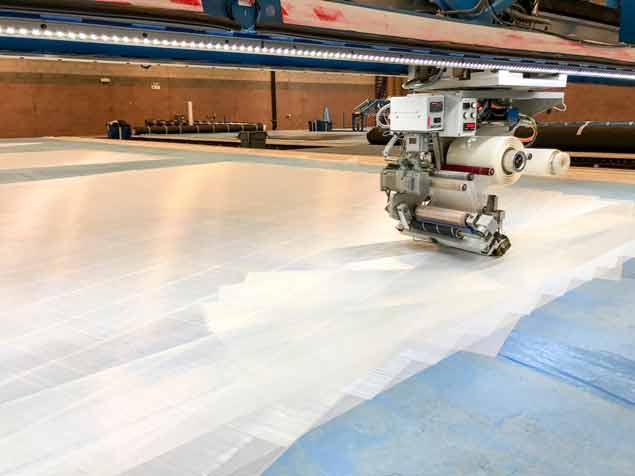 To create a North sails 3di sail woven cloth is calendared with high pressure rolling
To create a North sails 3di sail woven cloth is calendared with high pressure rolling
UNIQUE TO YOU
North Sails is unique in its position of offering cutting edge sail technology to a wide range of sailors and boats. Born from the America’s Cup, 3Di is available to Grand Prix Around-The World Ocean Racers and family cruisers alike.
COMPOSITE CONSTRUCTION
3Di composite construction is unique in the sailmaking industry. Like other high-performance composite structures, only fiber and adhesive are in these sails. Spread filament prepreg tapes are interleaved, in varying numbers of layers and a multiplicity of orientations to best handle both the tension loads and the compressive forces in any given sail. The ability to precisely align fibers and vary fiber density throughout the sail membrane, optimizing the sail structure for the anticipated loads, is the essential advantage of composite construction. 3Di does not contain Mylar film, scrims, or taffetas. 3Di is not subject to the lamination problems of string sails, making them more durable and long lasting.
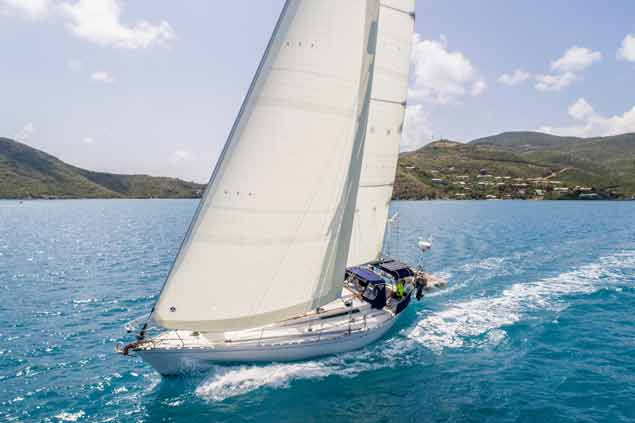 The sail’s shape and durability are permanently locked into the rigid airfoil that is customized to the user’s sailing preferences
The sail’s shape and durability are permanently locked into the rigid airfoil that is customized to the user’s sailing preferences
PERSONALISED SHAPE
North Sails is the only sailmaker in the world to build sails on full-sized 3D molds, inflated to the sails’ precise flying shape. Heat and vacuum pressure are then applied, consolidating the composite structure. The sail’s shape and durability are permanently locked into the rigid airfoil that is customized to the user’s sailing preferences
COMMITTMENT TO QUALITY
Batten pockets, reefs and patches are integrated into the tape structure. Finishing on a 3Di sail is minimal. Edge tapes, corner strapping and hardware are sewn by hand on the loft floor with careful attention to detail. All North sails are manufactured in wholly-owned facilities. Our Blue Book Standards for strict construction, material and labor standards result in consistency for all of our products. 3Di quality and North’s reputation for consistency has won North Sails exclusive supplier status to the 35th America’s Cup and the Volvo Ocean Race 2017-18.
3Di APPLIED
In addition to use in sails, North Thin Ply Technology has been adopted in a variety of high tech manufacturing applications. TPT flew around the world on the first non-stop solar powered aircraft and can be found in advanced golf shafts, Southern Spars masts and booms, and F1 motorcars. When using 3Di sails, you are joining an elite group who has chosen the world’s leading composite technology.
More about 3Di technology
THE NEW STANDARD FOR PERFORMANCE AND DURABILITY
North Sails 3Di exemplifies outstanding value with industry leading shape holding and a longer service life compared to other sailmaking technologies. Proprietary engineering and construction methods allow 3Di sails to maintain their shape to an unprecedented level. Superyachts now use one set of 3Di sails for racing, cruising and deliveries. Volvo Ocean Race teams trust one mainsail for 35,000+ miles around the world; they formerly used two or three string laminate sails. Circumnavigators are using 3Di sails for multiple laps. Do the math, and you’ll find that 3Di sails have a lower cost of ownership than any other sails in the world.
ONLY THE ESSENTIALS
3Di sails are significantly stronger and lighter than our competitor’s laminate string sails when made of comparable materials. Filaments are the elemental form of fibers. What we think of as a yarn used in traditional sailcloth and string sails are in fact a twisted bundle very small filaments, each less than the diameter of a human hair. Using filaments instead of yarns in sail constructions allows better exploitation of the fiber properties.
For further information about 3Di NORDAC visit northsails.com or download a press pack below
Irish Sailing Cruising Conference Features 'Rogue Trader' Adventure
The third Irish Sailing Cruising Conference 2018 returns to Dublin on 17 February 2018, at the Clayton Hotel in Leopardstown, just off the M50 in South County Dublin.
The conference is a popular event on the sailing calendar for cruising sailors to swap stories and catch up on new ideas before they plan their destinations for the summer and beyond.
The carefully chosen talks for 2018 include:
As previously reported by Afloat.ie, The Adventures of Rogue Trader with sailors Claire McCluskey and Nick Russel telling us about their journey to buying, restoring and registering a 56ft wooden ketch and then venture off sailing west in the ARC in the Autumn and returning the following year.
An Taisce will be talking about their Clean Coasts programme and we take a look at what sailors can do to make a difference.
The Wooden Boat Project with Evie Conway and her one woman restoration of Saoirse, her beloved 26ft mahogany folk boat
The Irish Marine Weather Buoy Network will be explained and how the Marine Institute meets the needs of mariners, forecasters and researchers with Aodhan FitzGerald, Research Vessel Manager, Marine Institute
Managing Offshore Storms demonstrated by experienced offshore sailor and author Alex Blackwell
New Developments in Infrastructure presented with navigator Norman Kean of ICC Publications
Fishing Gear Marking open discussion on the problems and ideas for solutions with Norman Kean
To give an opportunity for small group discussions, workshop and discussion stations are organised with the speakers and marine professionals, while Teas and Coffees are served.
'Thanks to Sponsors Union Chandlery and support of Cruising Association of Ireland we can keep our entry fee down to a reasonable rate. Irish Sailing Members €25 and Non Members €30, includes a Carvery Lunch at the Clayton, Irish Sailing's Gail McAllister told Afloat.ie
Tickets are here
David Whitehead 1942-2017
Irish sailing is mourning the loss of someone very special with the death of Dave Whitehead of Kinvara. In his close and strong family circle, throughout an international circle of friends, and among many more in the Galway Bay area, the loss is made more poignant by the fact that he was a very active 75–year-old, brimming with plans for the future, and keenly interested in every aspect of the world today, both within and beyond sailing.
His life story is a tale of our times. From Monkstown in County Dublin, he was of a technically-minded family – a great-grand-uncle had invented the Whitehead Torpedo, the first in the world. Young David had started his sailing in Dublin Bay, but after graduating in geology from Trinity College, his career path was in mining, which eventually took him to many corners of the globe, some of them very remote, and others also very far underground.
However, an early position in the late 1960s was with Tynagh Mines in the southeast of County Galway, headed by Dave FitzGerald who shared his love of sailing. For a while they were much involved with the little sailing club which functioned at the time on the lake at Loughrea. But the call of the sea and the possibility of a club being established on Galway Bay drew their sailing interests westward, and during the early 1970s David Whitehead contributed much to the early life of Galway Bay Sailing Club, which was being spearheaded by determined enthusiasts like Pierce Purcell and others.
Dave had maintained his friendships with Dublin Bay sailing, and through John Bourke with Jack McKeown’s S&S 34 Korsair, he was able to introduce the new sailors of Galway, who at that time were experimenting with being based on Lough Atalia immediately east of the city, to the invigorating realities of offshore racing with ISORA.
Dave himself was soon to go on to become elected to both the Irish Cruising Club and the Royal Ocean Racing Club. But meanwhile in Galway the neophyte club accepted his and David FitzGerald’s advice that they should locate their main sailing base at Renville near Oranmore at the head of Galway Bay, and soon Dave Whitehead was making an active input to the GBSC as a sailor who introduced some interesting craft to the growing fleet at Renville, and as a member of the committee.
 Always absorbing information. Dave Whitehead taking on board some new facts while on passage from the Azores to Ireland in 2008. Photo: Ed Wheeler
Always absorbing information. Dave Whitehead taking on board some new facts while on passage from the Azores to Ireland in 2008. Photo: Ed Wheeler
The Honorary Secretary in those early days was Marie White, and in each other they found kindred spirits, and were married. They shared the hope that they would live in due course on the shores of Galway Bay, but to achieve that Dave first had to see through a very concentrated international career in mining. In this, with Marie’s support, he was very successful, working extremely hard both in the field and in board-rooms, rising rapidly through the ranks to achieve positions of significance in the leading global commodities firm Billiton – at the time of his death last week, he was chairman of a number of Billiton’s London-based subsidiaries.
He and Marie had long since also succeeded in returning to Galway Bay, buying The Glebe in Kinvara and turning it into an idyllic family home. As for sailing, his interest was if anything greater than ever, and though he had always made a point of finding the best sailing within reach of wherever his various mining jobs took him, his heart was with Galway Bay, where he went though an intriguing array of boats ranging from the Quarter Tonner Frantic aboard which many young GBSC sailors took their first steps afloat, to the classic miniature S&S 27 Shemite – all of them boats which have remained with the Galway Bay fleet under new owners.
One he’d achieved his dream of finally settling in the west (where, during his and Marie’s absence abroad, the members had built the first GBSC clubhouse at Renville in 1979) Dave Whitehead was able to put experience gained at many other sailing centres to good use. Though he’d never had any formal training in race management, Pierce Purcell fondly recalls that he proved a natural as a Race Officer, providing his services with enthusiasm, and running things afloat very competently and without fuss.
But by now his main enthusiasm in sailing was in cruising, while in life generally it was about learning even more to add to the huge stock of knowledge in his already well-furnished brain, and its deployment on the lively discussions which he relished. Fellow Irish Cruising Club member Ed Wheeler, himself no slouch when it comes to conversations in depth, recalls a voyage home from the Azores crewed by Dave: “The wind-driven autohelm was working very well, so inevitably at mealtimes, and indeed at many other times, there were discussions as we sailed along. You might think you had talked Dave around to your way of thinking, but then he would come up with some totally unexpected but indisputable and perfectly-remembered scientific fact from his warehouse of mental information, and the argument was back to square one”.
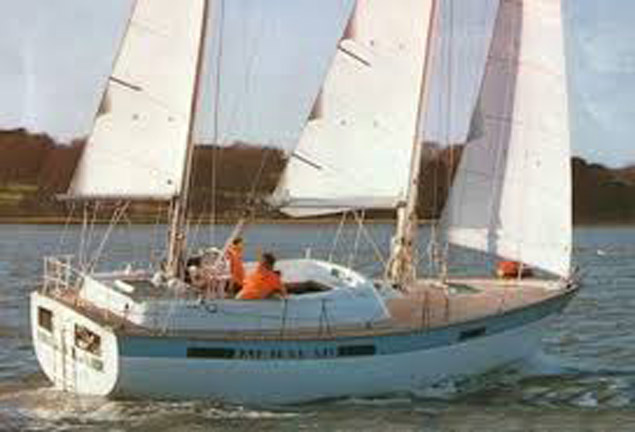 The unusual dreamship. While Dave Whitehead’s smaller gunk-holing craft were often of traditional appearance, much of his offshore cruising was done with the highly-individual Oyster Mariner 35 Joyster, a Holman & Pye design which packed an astonishing amount of accommodation into a compact hull which performed very well
The unusual dreamship. While Dave Whitehead’s smaller gunk-holing craft were often of traditional appearance, much of his offshore cruising was done with the highly-individual Oyster Mariner 35 Joyster, a Holman & Pye design which packed an astonishing amount of accommodation into a compact hull which performed very well
Typically of Dave Whitehead, when making a Transatlantic passage as crew with Marie aboard La Contenta in the ARC of 2003, the very fact of the boat being well equipped with the latest in electronic navigation aids prompted him to bring along traditional bits of gear to calculate their position, and by the end of the voyage not only was he getting his calculations absolutely spot on, but he had worked out ways of simplifying the time-honoured methods used by the likes of James Cook and other great voyagers.
For his own principle cruising boat, he was for many years content with the ingeniously-laid-out Holman & Pye-designed Oyster Mariner 35 ketch Joyster in which he voyaged near and far, and was rewarded with ICC and GBSC trophies. But from the moment he settled in Kinvara, he was also fascinated by the miniature cruising possibilities – the “gunk-holing potential” – of the much-indented southern and eastern shores of Galway Bay. To explore them properly, he went through an almost bewildering variety of small specialist cruisers with lifting keels and easily-handled rigs which enabled him to get to places where no cruising boat had ever been seen before.
With his base now in Kinvara, he could also contribute to the changes in the perceptions in the rest of Ireland of the level of sailing in the west, and together with Dave FitzGerald, he was much involved in a major re-balancing of the structure of the Irish Cruising Club. This began with an increase in western-based Committee members, then there was a western Rear Commodore, and eventually Dave FitzGerald served as Commodore from 2000 to 2002, while Dave Whitehead was Rear Commodore from 2006 to 2008, and Vice Commodore from 2009 to 2011.
In his later years, he made the shrewd judgment that the unpretentious but very cleverly-designed Moody 27 was the ideal boat for his main cruising needs, while continuing to work with specialists like boat-builder Tiernan Roe of Ballydehob in West Cork towards creating the perfect gunk-holing cruiser for places “where the water is very thin”.
In sailing the Moody 27 Mystic, he found an ideal crew in the equally individualistic Peter Fernie who lives on Tawin Island, which is well out in Galway Bay, though connected by a causeway to nearby Ireland. As matched spirits, they moved into an ownership partnership which worked very well, and a round Ireland cruise with an extended visit to the Hebrides in 2016 saw them being awarded GBSC’s David Baynes Cruising Award in the face of some formidable competition.
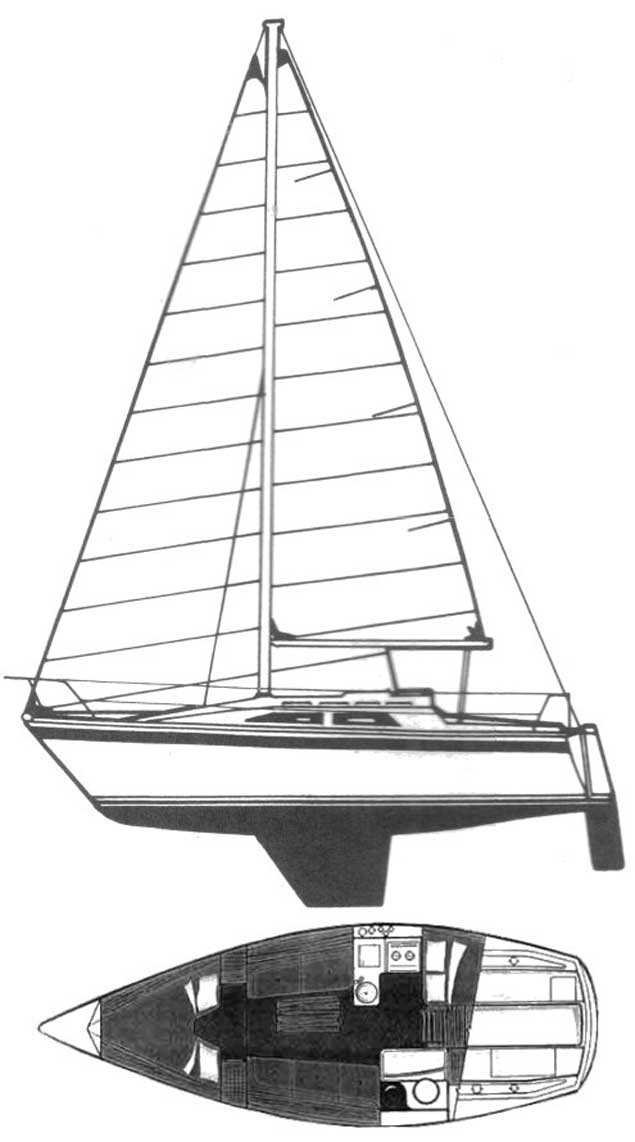 David Whitehead’s last seagoing cruiser was the Moody 27 Mystic, which he latterly co-owned with Peter FernieIt is Peter Fernie’s response to the death of David Whitehead which best captures the essence of this remarkable man, and with his permission, even though it re-phrases some of what we’ve already said, we are honoured to publish it here:
David Whitehead’s last seagoing cruiser was the Moody 27 Mystic, which he latterly co-owned with Peter FernieIt is Peter Fernie’s response to the death of David Whitehead which best captures the essence of this remarkable man, and with his permission, even though it re-phrases some of what we’ve already said, we are honoured to publish it here:
“David Whitehead: A memoir by Peter Fernie
David Whitehead was never lost for words. Whether it was boats, or maritime history in general, mountaineering or rugby, climate change or electric cars, you could be certain that David would have a well thought out position. More often than not, his was a contrary one to the accepted or establishment view, but a position backed up by his incomparable memory.
Despite his losing keys and mobile phones like the rest of us, I often wondered whether David had ever forgotten anything he had read or seen in the past. His prodigious recall was exemplified once when sailing up the Cleddau River in Wales, above Milford Haven. This location was not part of our plan, but we had ended up there en-route to Brittany, owing to a number of engine-related difficulties. David spied a moored wooden cutter, and we sailed across to get a closer look. Triumphantly he said: “That’s Driac” and proceeded to give me a detailed history of the 1930s Nicholson built boat: her original owner and cruises, as well as various assorted related ephemera comprising the establishment of the National Maritime Museum in Greenwich, and the evacuation of the B.E.F. from Dunkirk. I always assumed that he had this stuff printed on the back of his eyelids. In the event I googled Driac when I got back home – he was absolutely accurate.
Moving to Galway in the ’60s, he had sailed up and down the west coast and further beyond with David Fitzgerald (ICC). His training as a geologist found him working with mining concerns around the world but wherever he was, he found time to sail. He was a founder member of Galway Bay Sailing Club and became a member of the Royal Ocean Racing Club and the Irish Cruising Club in 1972. He became a member of the Royal Cruising Club in 2008.
He had raced and cruised many different boats since his days in Trinity College, Dublin. He had owned boats large and small from his first, a 16 foot Paul Gartside designed gaffer to his latest, Goblin, a 16 foot Chesapeake Bay microcruiser which he adapted for gunkholing around Galway Bay creeks.
In 2009 whilst Vice Commodore of the Irish Cruising Club, he was diagnosed with lung cancer which he attributed to working in an Australian uranium mine. Nevertheless, and despite major surgery he was sailing his Oyster Mariner 35 Joyster three months later to Tory Island and Lough Swilly. Despite a continually compromised respiratory system, David never let this get in the way of his sailing, with cruises to Wales, Brittany, the Isles of Scilly and the Aeolian Islands as well as the south and west coasts of Ireland. In 2016 we sailed from Galway to the Hebrides and back around Ireland clockwise to Galway in our Moody 27 Mystic.
This year, he was sailing in Galway Bay several days before a forthcoming hip replacement operation. Next year was to be an extended cruise to Galicia, as well as a gunkholing cruise in Roaring Water Bay.
He was an excellent shipmate and a great companion. He could be uncompromising and pedagogic but was never boring. He was unremittingly positive about life and dwelt always on the future whilst enjoying the past. He will be missed by many”.
Our heartfelt condolences are with David Whitehead’s wife Marie, his son Duncan, his daughters Jennifer and Siobhan, his daughter-in-law Kerry, his grandchildren, and his extended family and very many friends. May he rest in peace.
WMN
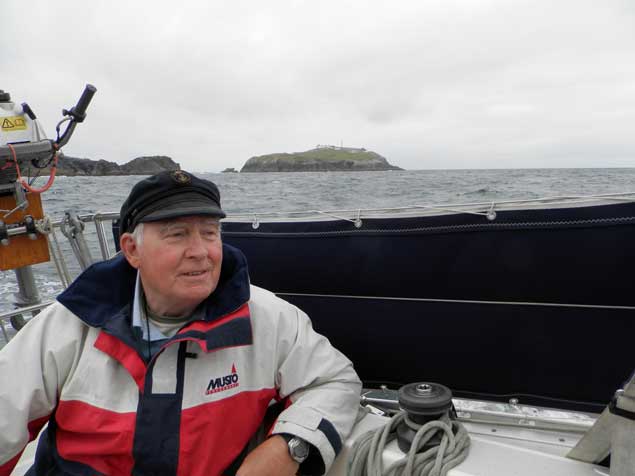 The last major cruise. Dave Whitehead at the helm of Mystic in June 2016, emerging from Broadhaven in Mayo, bound for the Hebrides with Eagle Island to seaward. Photo: Peter Fernie
The last major cruise. Dave Whitehead at the helm of Mystic in June 2016, emerging from Broadhaven in Mayo, bound for the Hebrides with Eagle Island to seaward. Photo: Peter Fernie
Eamon Crosbie's Discovery 55, 'Pamela' Sets Sail on the ARC Rally
The only Irish registered yacht in this year's Atlantic Rally for Cruisers (ARC) is Eamon Crosbie's Discovery 55, Pamela.
As Afloat.ie reported earlier Crosbie set off from Dun Laoghaire on the adventure with Dublin Bay Sailing Club's Brian Mathews on board. Mathews will be absent from Dublin Bay racing for about a year, having joined Crosbie, a former Round Ireland Race winner, in what is the start of a world cruise.
An international fleet of yachts taking part in the 32nd edition of the Atlantic Rally for Cruisers (ARC) set sail on Sunday from Las Palmas de Gran Canaria, beginning an amazing transatlantic journey to the Caribbean island of Saint Lucia.
It is a particularly diverse fleet this year with boats from 30ft to 95ft setting off on the same transatlantic course, including 156 monohulls, 28 catamarans and 2 trimarans. The sailors themselves are just as varied, aged from 3 years old to over 80.
While the ARC is a cruising rally, there is a start and finish line, and the boats are split into divisions according to size, type and competition. The first start today was for the multihull division, led over the line by American flagged Lagoon 42-4 Libelula, followed by Seawind 1160 X86 and the fleet's largest trimaran, Rapido, living up to her name coming over the line third before storming off down the Gran Canarian coast.
Following on, 27 boats in the ARC Racing Division were equally eager to stretch their sea legs and sail out into the Atlantic. Regular ARC Skipper and Class winner Ross Applebey brought through Scarlet Island Girl hot on her heels swiftly followed by Valerio Bardi's Swan 46 Mk II Milanto.
The first boats to cross the line in the Cruising Division were Norwegian Arcona 400 Tiffin, Swedish Najad 460 Ellen and British Grand Soleil 56 Mad Monkey.
Of the 186 boats sailing on the ARC direct route, 4 are still in Las Palmas with technical problems delaying their departure.
The majority of boats will take 18-21 days to make the 2700 nautical mile Atlantic crossing, arriving in Rodney Bay Marina, Saint Lucia.
Tracker here



























